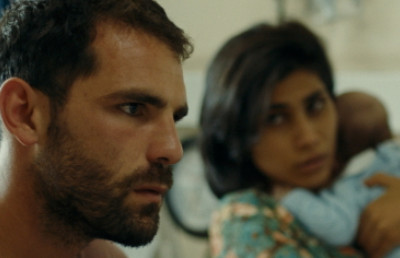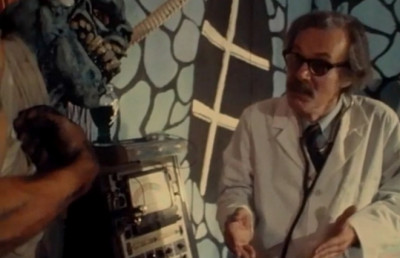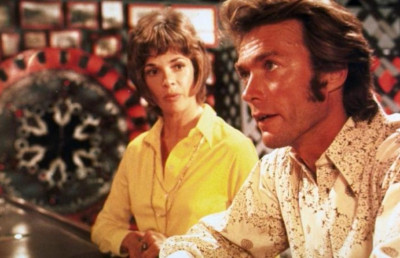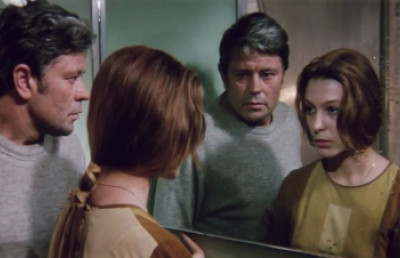Experiments in Polyphonic Cinema: Observations of Precision Temporal Matching Between Solaris and 2001: A Space Odyssey
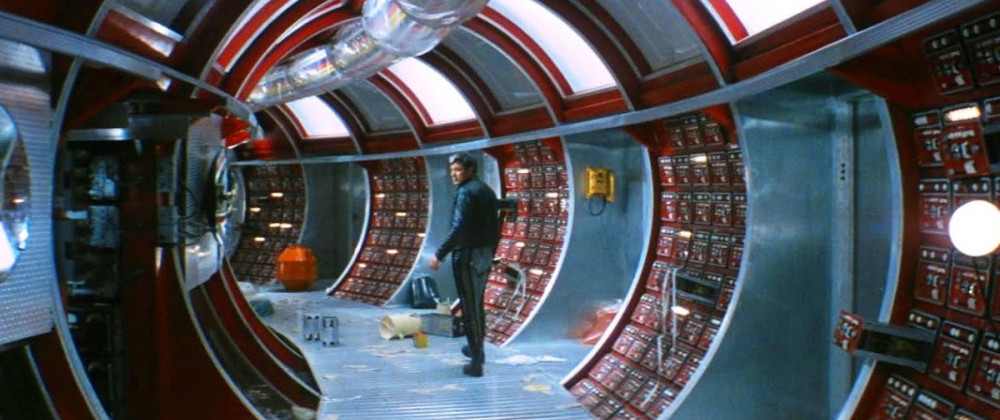
Preface

In this essay I posit the theory that Solaris (Tarkovsky, 1972) was temporally matched to 2001: A Space Odyssey (Kubrick, 1968) with a very high level of precision by Andrei Tarkovsky and his team; I provide some examples of how this obscure structural principle is expressed; I speculate as to some reasons why such an experimental approach was adopted; and I offer some interpretations arising from the synchronized screening of both films as a combined, time-locked ‘polyphonic film’. As an appendix, I give some simple instructions for accurately synchronizing the two films for side-by-side screening, and some reasonable conditions for ensuring a decent audio mix.
Introduction
It is well established that Solaris was realized as a reaction to 2001. Both films have a special role within the frame of Soviet / American Space-Race era propaganda 1 and, as two highly original and well executed works of auteur cinema, they transcend their Cold War contexts through a deeper questioning of “the limits of human comprehension” (Cavedo 107). In addition to their dissimilar approaches to existential questions, these films form an intertextual dialogue which reaches into the minute details of their cinematic mechanics. In light of such microscopic and macroscopic dialogues, Solaris and 2001 add up to something greater than the sum of their parts. Within this relationship there is an echo of Bakhtin’s literary theories of dialogism and the polyphonic-novel.
Comparisons more often tend towards ‘monologic’ readings of both Solaris and 2001 with a decidedly limited space for mutually transformative dialogics. Interactions which seem to run deeper than more generalized ‘cold/sterile’ versus ‘emotional/humanistic’ dichotomies tend to be ascribed to largely naïve gestures on behalf of Tarkovsky. In reaction to the video-essay Auteur in Space (Kogonada, 2015) for instance, one reviewer notes that “Solaris acts as almost a conscious reaction against the Kubrick film” (Guidry). When acknowledging “Tarkovsky’s emotional response to and even rewriting of 2001”, another commentator wonders if Tarkovsky “was not subconsciously influenced by the film” (Cavedo 141). Besides attributing an increased sense of conscious agency to Tarkovsky as an artist and theorist, a closer reading and more dialogic interpretation of Solaris’ intertextual relationship to 2001 reveals an alarming level of simultaneous and sequential audiovisual conversation occurring on a scene-for-scene (often shot-for-shot and sometimes frame-for-frame) basis. Analysis of these dialogic interplays indicates the employment of a self imposed and rigidly formalized system of structural restraints on behalf of Tarkovsky.
As theoretical models, expanded from literature to encompass cinema, dialogism and the polyphonic-novel offer a tentative framework for studying the structure of Solaris on its “deepest molecular and, ultimately, subatomic levels” (Bakhtin 300). These literary theories would seem to apply more effectively to Tarkovsky’s film if we step back to the musical roots of Bakhtin’s polyphonic analogy and pay special attention to the inherent (clocklike) temporal nature of cinema: a uniquely objective, mechanically sequenced temporality. This mechanical essence, or rather the precision temporal reproducibility of fixed-media, would theoretically allow for one film to be ‘harmonized’ with another film in exacting, repeatable, mechanically synchronized detail.
I have made an accompanying video-essay to help demonstrate my observations of precision temporal matching between 2001 and Solaris. To say that Tarkovsky minutiously synchronized his film to Kubrick’s is a pretty tall claim after all, and it should require some compelling evidence to be asserted. Given the extra level of effort required on behalf of Tarkovsky, plus the fact that the link doesn’t seem to have been established in 50 years, such claims should warrant a healthy degree of skepticism. My main goal here is to try to illuminate a very unconventional and heretofore unnoticed polyphonic-cinema 2 experiment encapsulated as something of a hidden layer in Tarkovsky’s film.
“…we had already seen Kubrick’s 2001: A Space Odyssey, which served as a basis for comparison…” (Yusov 4:19)
Structural appropriation, such as the use of musical temp-tracks or the employment of existing narrative formats is commonplace in filmmaking and was integral to 2001. 3 But Solaris seems to step beyond merely using 2001 as a readymade spatio-structuro-temporal schematic, it’s as if the films were meant to be screened side-by-side. Doing so enables a rewarding aesthetic experience which relies on an elaborate and dynamic system of cinematic counterpoint. One starts to get the feeling of – if not some sort of quantum entanglement – an extensively deliberated and well crafted harmony. Scenes begin, end, and transition together; there is a consistently strong referential interplay of visual elements including set-design, colour-scheme, costume, montage, and camera movement; dialogue and action from one film often serves to synchronistically converse with dialogue and action from the opposing film; the same holds true for sound-effects and for music. For his decoding and re-encoding of Kubrick’s poetics, Tarkovsky has provided us with a temporal map for contextualizing his many instances of pointed commentary.
“By manipulating the effects of context, it is very easy to emphasize the brute materiality of another’s words, and to stimulate dialogic reactions associated with such “brute materiality”; thus it is, for instance, very easy to make even the most serious utterance comical.”(Bakhtin 340)
On the whole, Tarkovsky’s cinematic response appears as a very serious and probing art-work, and there is something of an homage to A Space Odyssey embedded in Solaris. But additionally, and perhaps counter to readings of Tarkovsky’s oeuvre as almost “totally deprived of humour and jokes” (Žižek), we find both comedic parodies of Kubrick and a broader application of satire. With jokes which seem reminiscent of Mystery Science Theatre 3000 4 , Tarkovsky mocks 2001’s visual effects, sound effects, script, and other elements of the film. Using his characters’ dialogue, and with an idiomatic wave of the hand, Tarkovsky casually dismisses some of Kubrick’s attempts at profound statement as simply “meaningless” or “ghastly”. Beyond mere frivolity, such jokes approach Bakhtin’s carnivalesque and serve to recontextualize 2001’s constituent parts and expose some of its deeper problems. Through an emphasis on the “brute materiality” of cinema, this running commentary issued from Solaris provides a kind of Verfremdungseffekt as it begins to flatten the cinematic illusion of 2001 and remind us that we are merely watching a film.
Beyond the many discrete points of temporal contact between 2001 and Solaris, there exists an overreaching sense of ‘harmony’ or ‘visual music’ interwoven between a synchronized parallel screening of the films. Together they become a new film whose progressively more intertwined interactions are so well rounded and fluid as to feel effortless. What follows is an outline of some notable time-locked counterpoints which serve to create this sense of harmonic intertextuality.
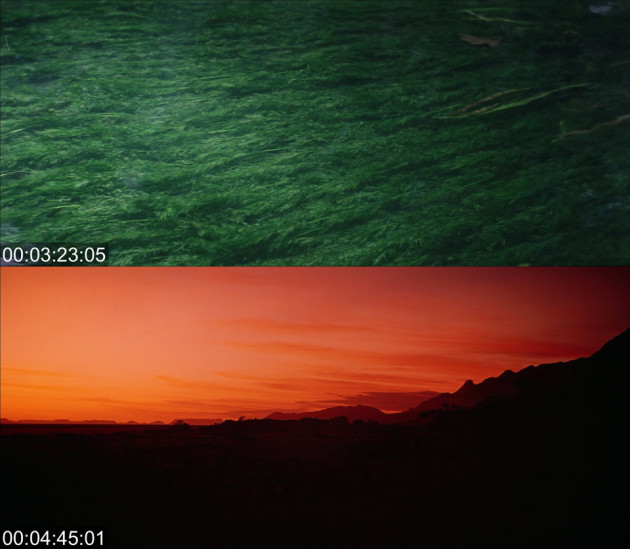
Departure Points
When lining up the opening shots of 2001 and Solaris on a nonlinear editing system, I compared the films’ introductory material and made some notes of their visual counterpoints:
red / green
distant / close
dark / bright
dry / wet
dead / alive
still / moving
prehistoric / contemporary
hostile environment / nurturing environment
A side-by-side juxtaposition of these openings produces a striking diptych 5 , harmonious both visually and through the depth of meanings which inform the images.
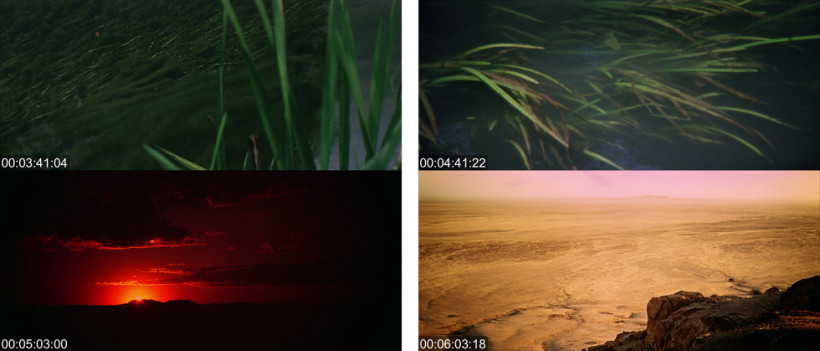
Now it’s easy to imagine how the opening shots of any given film might make very intentional references to the opening shots of another film. With a knowledge of Tarkovsky’s polemic relationship to 2001, it had long been my running assumption that the green ‘water-reeds’ opening of Solaris was a conscious visual-counterpoint to Kubrick’s ‘red-dawn’. It seemed safe to suppose that from these oppositional departure points, the films diverge along their own unique paths to their own ends, according to their own unique sets of rules. With some derivative visual-rhyming in the mise-en-scène, and some easter-egg references scattered around for more astute viewers, the films could be regarded as more or less self-contained entities and compared more generally in terms of style, intentions, overall message and so on. However, as our hostile vs. pastoral landscape diptych develops into this polyphonic film, Tarkovsky’s initial use of visual-temporal counterpoint does not fade, it is maintained, eventually modulating to encompass a wider instrumentalization of cinematic devices.
At 07:36 6 , Kubrick changes pace with the sudden appearance of a leopard attack – from that point forwards we are brought closer into the world of the apes and their ape business. The leopard attack is followed up at 07:54 by Tarkovsky’s horse. In counterpoint to Kubrick’s wild leopard, our horse wears a bridle, he is tame. To drive this point home, the trotting horse changes direction in the frame, running back to screen left from where he came, as if to let us know that he is merely running around and not running away. 7 As with Kubrick’s leopard, Tarkovsky’s horse serves as an exclamation point which is used to transition the ‘time-pressure’ of action from the slow-and-distant mode of Solaris’s establishing material, to the quicker-and-closer pace of the following section.
“I probably shouldn’t have bothered you today”
From 08:00, protagonist Kris Kelvin descends to the surface of the pond and washes his hands, this temporally coincides with the apes dipping their hands into their coveted watering hole to drink. Then upstage in both films, visitors arrive. The apes make a violent fuss, the humans are polite, civilized, and familiar. From this point, the contrapuntal devices connecting the films begins to make use of character interaction to juxtapose different ideas of human social relations.
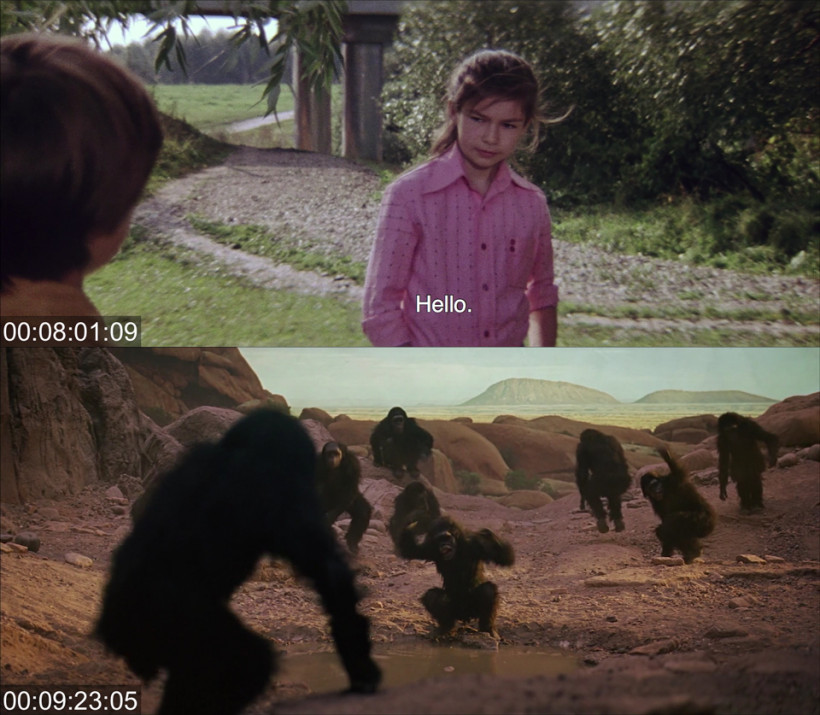
For 2001’s next event, we see the apes cowering in their caves at night. Here as before, we are reminded of how much they really do seem to hate their lives.
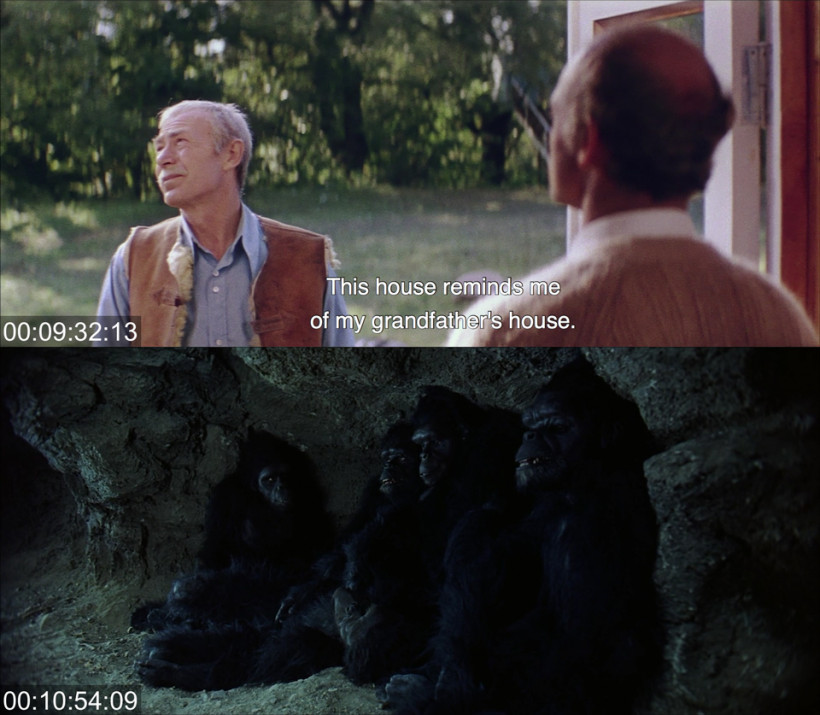
Berton: “It’s so pleasant here”, Kelvin’s father: “This house reminds me of my grandfather’s house, I really liked it…”. There’s a certain humour in this comparison, but it also serves in helping to expose and correct the cynicism Kubrick brings to our notions of humanity through his proposed Dawn of Man mythology.
At 11:07, suddenly alerted to something, Kris’s father and the boss-ape-patriarch simultaneously look skyward. Solaris: a summer storm; 2001: the call of a predator. The humans enjoy shelter 8 , the apes indulge in their fear of existential threat.
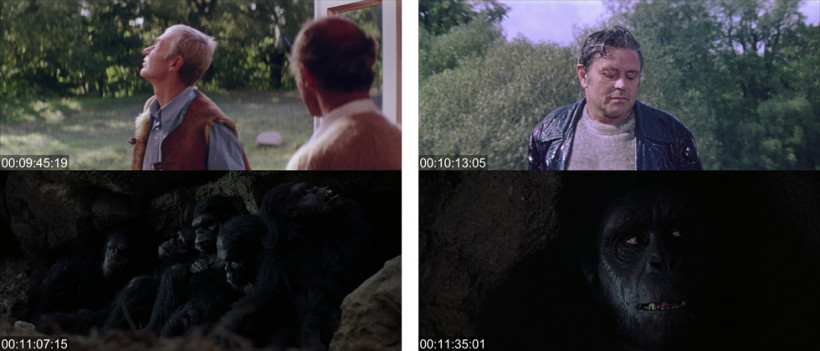
Then a simultaneous cut to closeups of Kris and our alpha-ape.
At 12:00, a clap of thunder on the soundtrack of Solaris seemingly wakens the Moon-watcher ape, and thus begins 2001’s first monolith scene. There appears two contrasting but interrelated notions of the sublime in the awe-inspiring technological wonder of the monolith (the thing out of place) conjoined with a sign of the raw-power of nature. Further into our polyphonic experiment, there appears quite a few moments in which diegetic and non-diegetic audio in one film quite precisely interacts with imagery in the other.
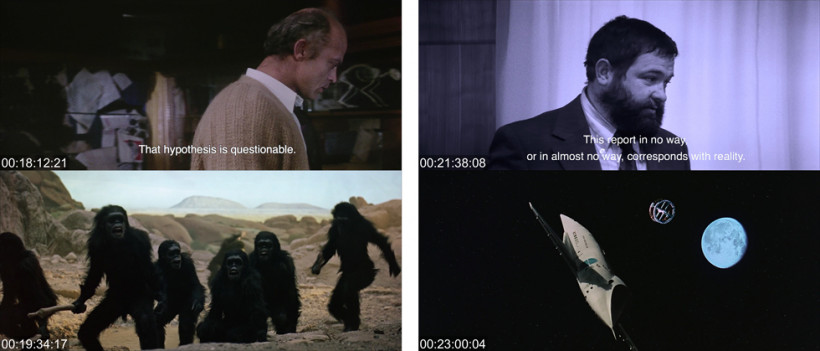
From the first monolith scene, and here also begins the Scientific Conference section of Solaris, we get the discovery and initial utility of Kubrick’s bone / club / weapon / tool. The Scientific Conference is marked by a general sense of skepticism. In the context of Solaris, this represents the inability of scientific institutions to come to terms with, or even acknowledge a new discovery. But as a dialogic interplay with 2001, it works to critique Kubrick’s vision as more of a ‘hallucination’ than a representation of reality. This contrapuntal voice of skepticism extends from The Dawn of Man and into Kubrick’s initial Earth orbit scene.
Sometimes a Cigar is Just a Cigar and Sometimes a Space-Weapon is Just a Space-Weapon
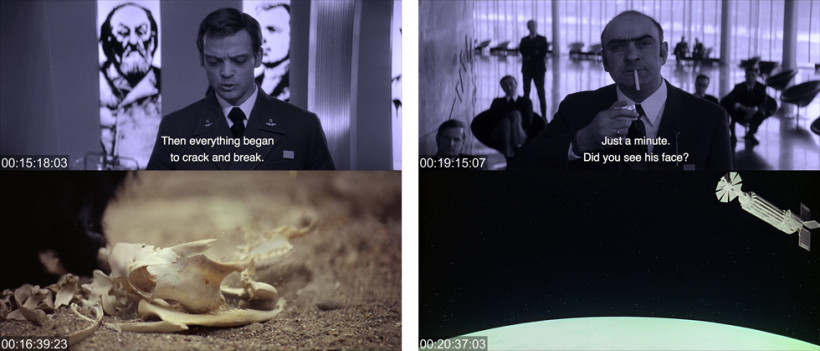
The raging alpha-ape tosses his bone-weapon aloft. 2001’s famous ‘jump-shot’ is immediately preceded with Berton saying, “The next part is meaningless”. He then begins to fast-forward his tape. At 19:45, Berton: “Let’s pick it up here”. From Berton pushing the play-button on his device, there is an audible ‘click’ and the Scientific Conference film resumes playback. This ‘click’ on Solaris’s soundtrack precisely coincides with Kubrick’s jump-cut, and this is accurate down to the frame.
So from temporally aligning the first shots of Solaris and 2001, a frame-accurate sound-cue and contextual action almost 20 minutes later serves to both acknowledge and parody Kubrick’s jump-shot. Besides offering a kind of ‘calibration event’ for synchronization of the films, the button cue and Berton’s “meaningless” comment is a pointed sarcastic dig at Kubrick’s alignments to dubious Freudian theories and cynical reading of human evolution. There is a subversive, and I dare say dismissive Tarkovskian humour at work here. Some 7 minutes later, the last time Berton interfaces with the mediaplayer device, he actuates a switch to stop his tape, and again an audible ‘click’ on Solaris’s soundtrack. This turns out to be precisely audio-visually aligned to the conspicuous press-and-release of a single button in the Kubrick film.
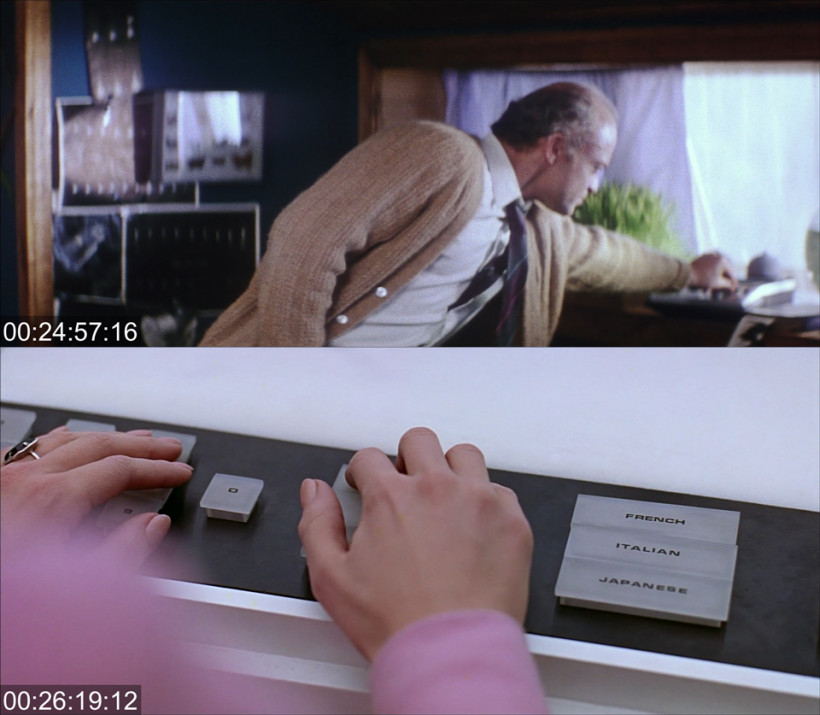
“You and I rarely get a chance to talk”
27:21, ‘Making Appointments’: Berton will wait for Kelvin by the swing. Halvorson will wait for Floyd in the restaurant.
28:05, “Playing”: Floyd speaks with his daughter through the ‘Bell-System PICTURE-PHONE’. Kelvin and his father watch the children playing outside through the open window of the house. Kelvin’s aunt appears in the scene wearing a very similar flower-motif dress to that of Floyd’s daughter.
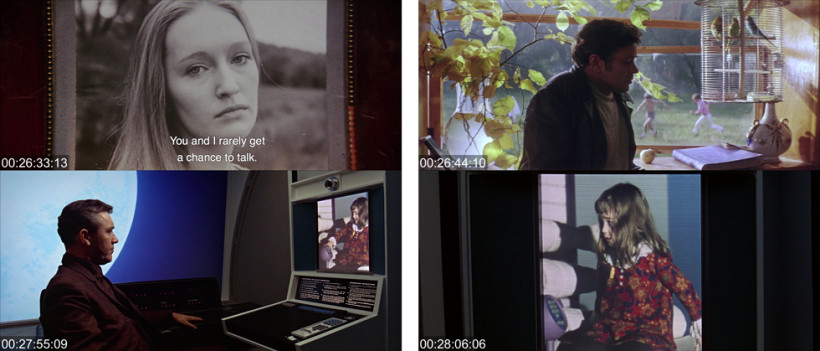
30:30, ‘Treehouse of Horrors’: Kubrick’s Russian scientists grovel for more scraps of disinformation at the crown-jewel of capitalism’s 21st century triumph: a Hilton in space. Berton and Kelvin discuss issues of science and morality. “Remember Hiroshima” 9 .
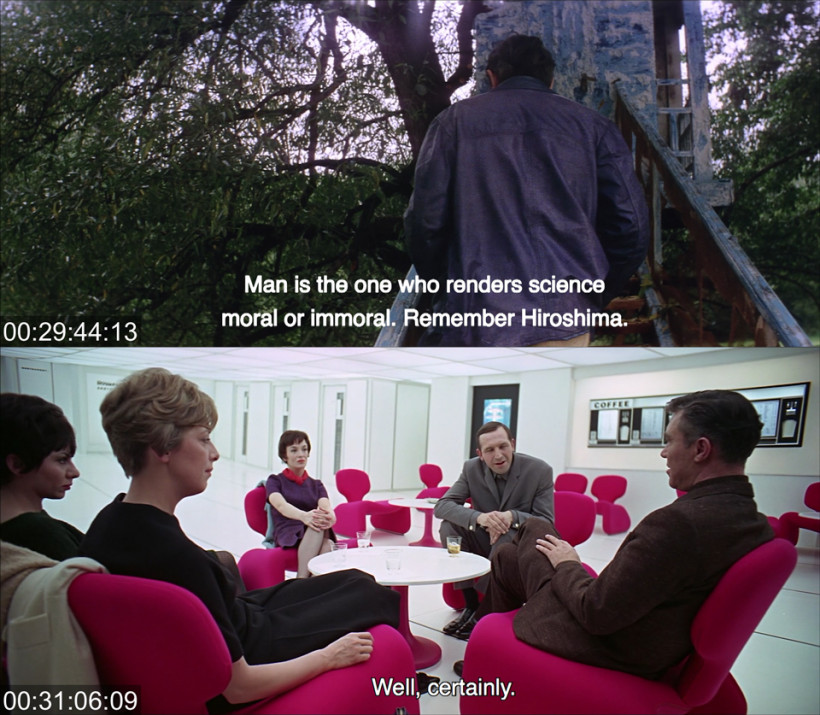
33:49 – 40:10, ‘In Transit’: Kubrick’s transit to the moon is locked to Tarkovsky’s City of the Future 10 . Techno-optimism meets a malaise of modernity.
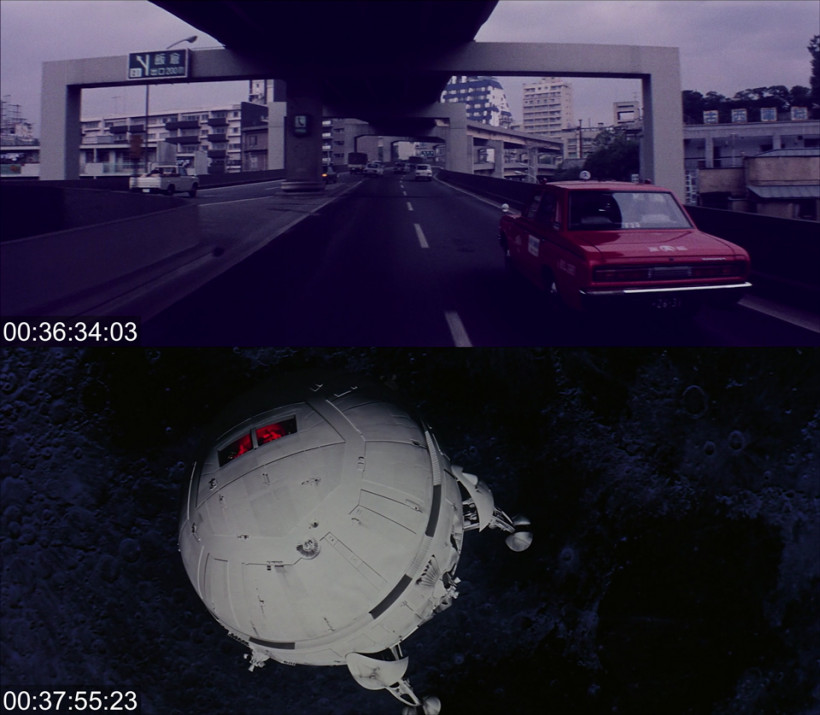
At 37:55, the appearance of the moonlander’s red window in 2001’s frame corresponds to the appearance of the red car in Solaris. This shot is the first break from black-and-white / monochrome material in the City of the Future section, and the film transfer appears to have been colour-timed to accentuate red, and to mute other colours 11 .
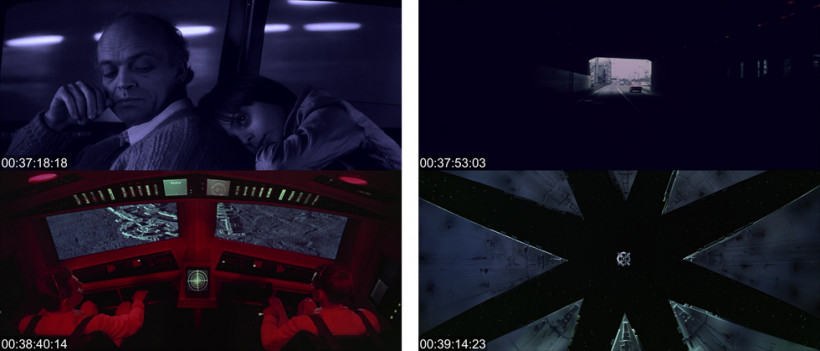
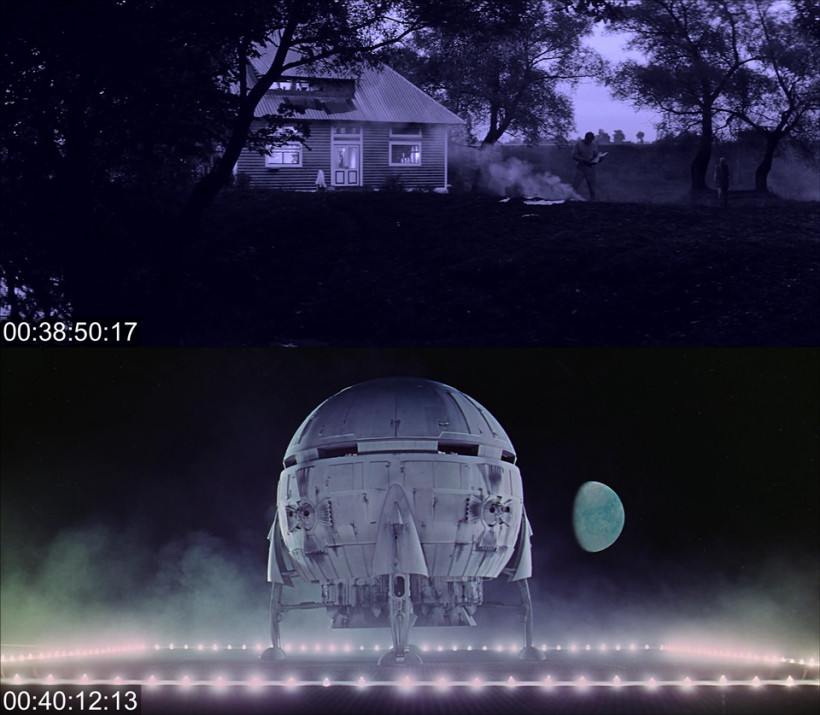
39:45, ‘Press Button to Cut Sequence’: at the push of a button in Kubrick’s film, we get a hard cut of Solaris’s image and sound as we are transported back to the dacha 12 , now rendered in monochrome film. This closes an most intriguing trio of frame-accurate ‘push-button’ synchronizations:
1) a button in Solaris ‘edits’ 2001, significantly at the film’s hardest cut [19:53]
2) both films press their buttons in synchronization [26:21]
3) a button in 2001 ‘edits’ Solaris, significantly at the film’s hardest cut [39:45]
40:12, ‘Arrival’: at the final descent of Kubrick’s moon-lander, Tarkovsky’s camera pans from pond to house. The vertical and horizontal movement in the frames of both films are of the same velocity. This kind of choreographed movement is a form of multi-screen synchronized motion-picture counterpoint which occurs numerous times going forward. Both shots cease their movements simultaneously as we arrive at our marks. The largely monochrome compositions with their smoke/dust elements bare more than a happenstance resemblance to one another. These images are conceptually entangled also.
41:07, “Any questions?”: Dr. Floyd’s briefing on the moon about secrecy surrounding the moon monolith discovery. Kelvin burns his thesis and other affects. There is a closeup of Kelvin’s eyes rotated from horizontal to vertical (landscape to portrait format) during his flight to Solaris Station. There exists a popular reading of the luminous walls and lecturn in 2001 as signalling ‘the cinema-screen = monolith turned sideways = the monolith as the cinema-screen’.
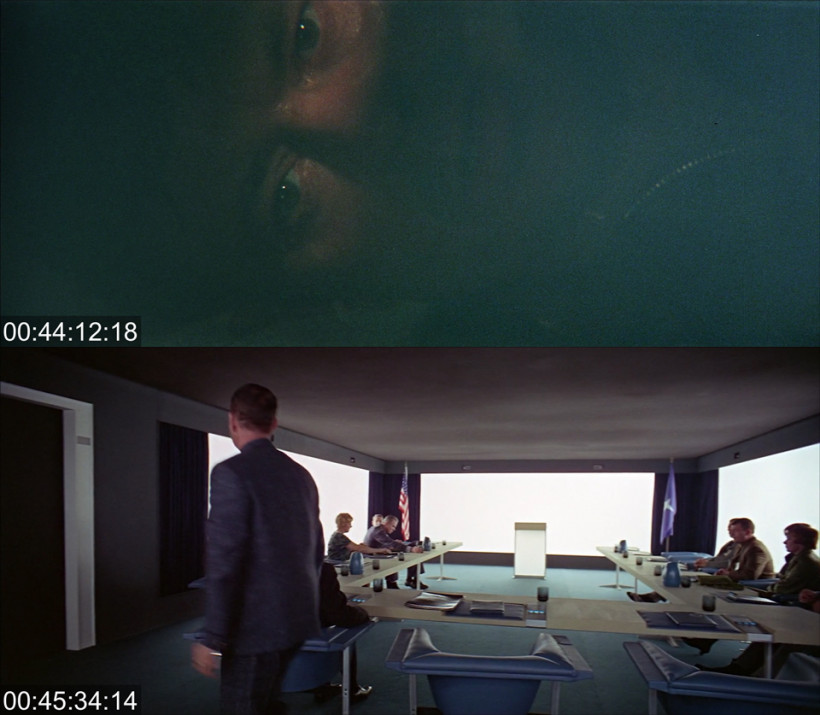
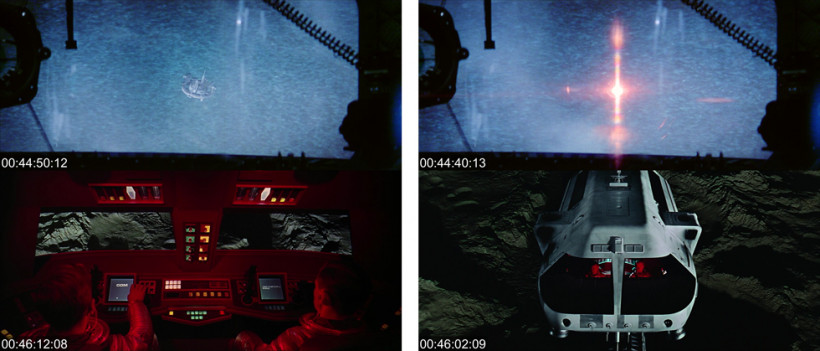
45:38, Floyd and company’s travel to the moon monolith by rocket-shuttle overlaps Kelvin’s approach to the Solaris Station. Earlier at Kelvin’s launch, the music of Solaris served to underscore 2001, and now 2001’s use of Ligeti’s “Lux Aeterna” effectively binds the imagery of both films.
49:40, ‘It’s Only a Model’: Kelvin meets Dr. Snaut. In addition to some other visual references, the use of a ball, and later a lamp set-piece seems to parody the visual effect of the Earth in the background of 2001. It’s as if Tarkovsky is pointing out Kubrick’s Earth lighting/phase technical error. 13

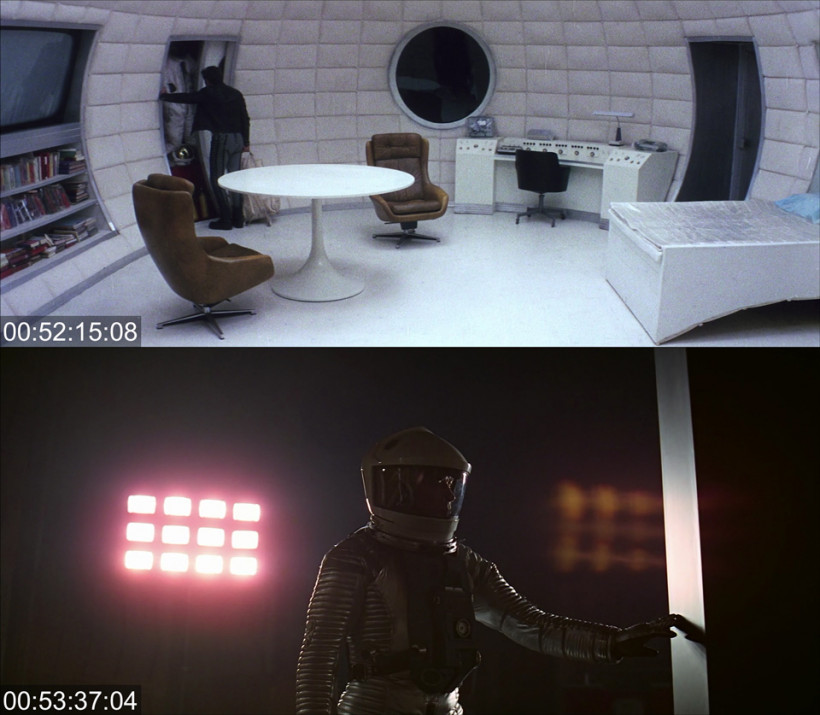
53:33, ‘A Hand Gesture, a Spacesuit, the Monolith as a Doorway’
54:32, ‘A Human’: a rough childish drawing of a human ensnared is paired with Kubrick’s monolith / celestial body conjunction. It’s interesting to see Kubrick’s symbol of technology in a supposed hierarchical universal order combined here with the image of a human in captivity. Besides a recapitulation of the monolith / door pairing and more obvious reference of visual composition, the contrasts to Kubrick would seem to comprise a philosophical counterpoint. Where Kubrick situates technology as an evolutionary and spiritual leap of progress, in Solaris, the “development of mathematical science strengthened the position of science and technology as a means of domination of nature, and their further development led to the subordination of man. Science and technology ceased to be subordinated by man and became independent forces dominating both man and nature” (Robertovna).
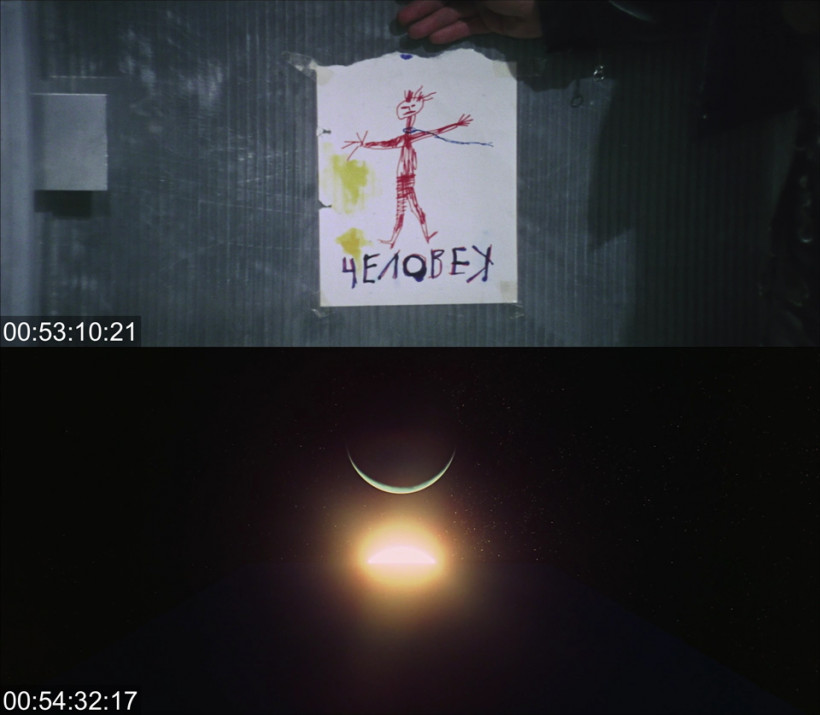
Recontextualizing the Decontextualized: Sometimes a Cigarette is an Armenian Cigarette
54:38 marks the beginning of Kubrick’s Jupiter Mission and simultaneously the next section of Solaris. The entrance of Kubrick’s bone-club-weapon-tool / Discovery Spaceship aligns with Kelvin’s entrance to Gibarian’s room on the Solaris Station. Discovery’s flyby is choreographically matched to Kelvin’s point-of-view survey of his former mentor’s room. Our eyes are led up to a musical manuscript, then we pan across a collection of civilization-signalling-artifacts including several Armenian objects. Consistent with Žižek’s reading of the opening of Star Wars (Lucas, 1977), Kubrick’s ship forms “a part of ourselves that we eject into reality”(Žižek). Kubrick has thus far gone to great pains to establish his ship as an object of Freudian id, and Tarkovsky seemingly seeks to negate this with an alternate reading of civilization. We travel across Gibarian’s objects, connected by ringlets of a computer’s ticker-tape paper past a circular window framing a void to our arrival at a personalized message: a warning.
Kubrick’s choice of music for this scene is “Gayaneh’s Adagio” from the Gayane Ballet by Armenian composer Aram Khachaturian. The music’s aesthetic powerfully connects the scenes in both films. The role of Gibarian was played by actor Sos Sargsyan, another prominent Armenian cultural figure. 14
As the communications mast of Discovery enters the frame, we are brought to a gun resting on the page of an open book in Gibarian’s room. The structure represented in the book is most certainly the Armenian Monastery of Saint Thaddeus. Located in modern-day Iran, it is regarded as one of the oldest Christian church sites in the world 15 . St. Thaddeus has been described as the brother of Jesus, his attribute is a club, or a boat, sometimes depicted with a carpenter’s rule, he was martyred (not unlike Solaris’s Gibarian), and he is the patron saint of lost causes and desperate cases.
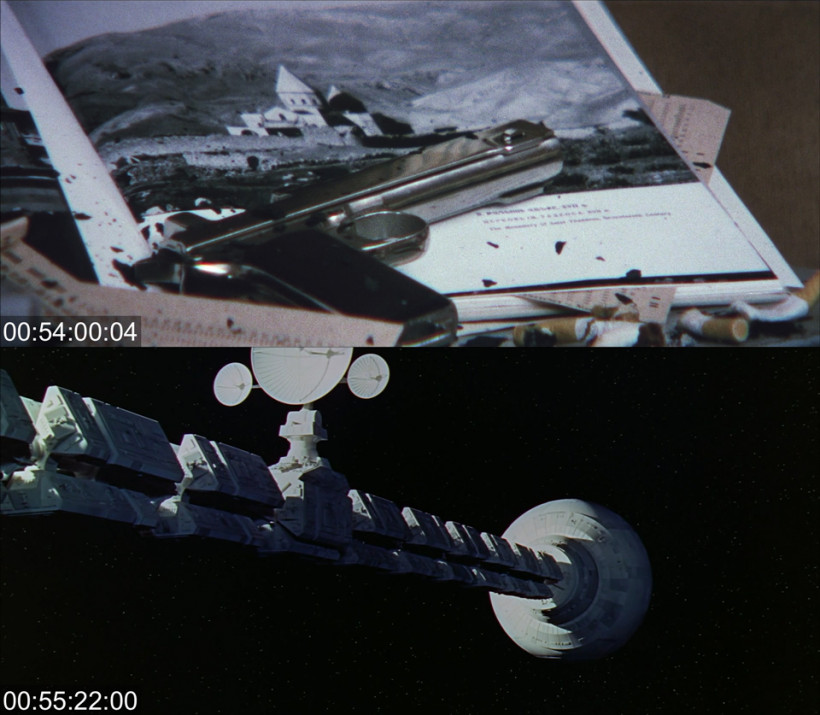
The gun would echo Kubrick’s spaceship-as-a-weapon motif, and this would be bound up with Gibarian’s warning: “I’m afraid that what happened to me is only the beginning…this could happen to you…it could probably happen to anyone”. But it’s through the Monastery of Saint Thaddeus that the Discovery-One ship is effectively reframed as a monastery in and of itself: a pioneering monastic outpost dedicated to the ‘religion of technology’. Its occupants certainly seem to live like monks. Further, it’s really not a stretch to conflate the expressions of NASA from 50 years ago with a decidedly Christian millennialist project. 16
At 57:42 we come towards the end/transition of this polyphonic scene with the simultaneous opening of doors: Dave enters the Discovery’s carousel, Kelvin pushes Gibarian’s door shut before anyone can enter.
“It’s exactly like being asleep, you have no sense of time. The only difference is that you don’t dream”
At 1:00:29, Frank’s (BBC-12 televised) discussion of the dreamless sleep of hibernation matches to a dolly track shot over the shoulder of Kelvin into (and out of) the blackness beyond as seen through the window of the Solaris Station. A connection between images of the hibernating astronauts’ vital-signs in 2001 with Sartorius and his laboratory is here established, and this recurs with each and every one of Kubrick’s recapitulations of this vital-signs imagery.
At 1:02:50, as part of an introduction to HAL, Frank says “he’s just like a sixth member of the crew”. It’s at this moment in Solaris, a dwarf attempting to escape Sartorius’s laboratory is caught and forced back inside. It seems here that when Kubrick says “thinking machine”, Tarkovsky says ‘Mechanical Turk’.
1:03:33, cut to Adagio reprise / Discovery flyby with a simultaneous cut to Solaris Ocean. The music on Solaris seems to insert the sound of Discovery’s engines. During Frank’s birthday message from his parents, Kelvin is led to discover Gibarian’s body in a freezer. A number of important themes are put forward here through image, dialogue, and music.
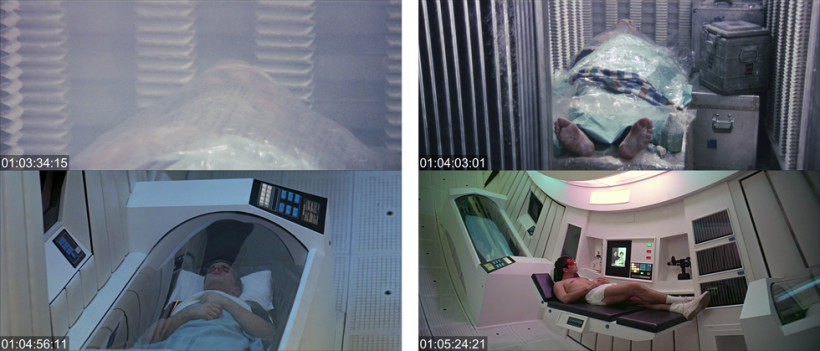
Some allusions here in 2001: “God bless you”, “…our illustrious son…”, Frank’s birthday, his impending martyrdom. In Solaris: Gibarian’s martyrdom, later quoting of Cervantes on sleep / death, the broader theme of sleep, dreams, resurrection. Like so many scenes across these conjoined films, they essentially begin and end together.
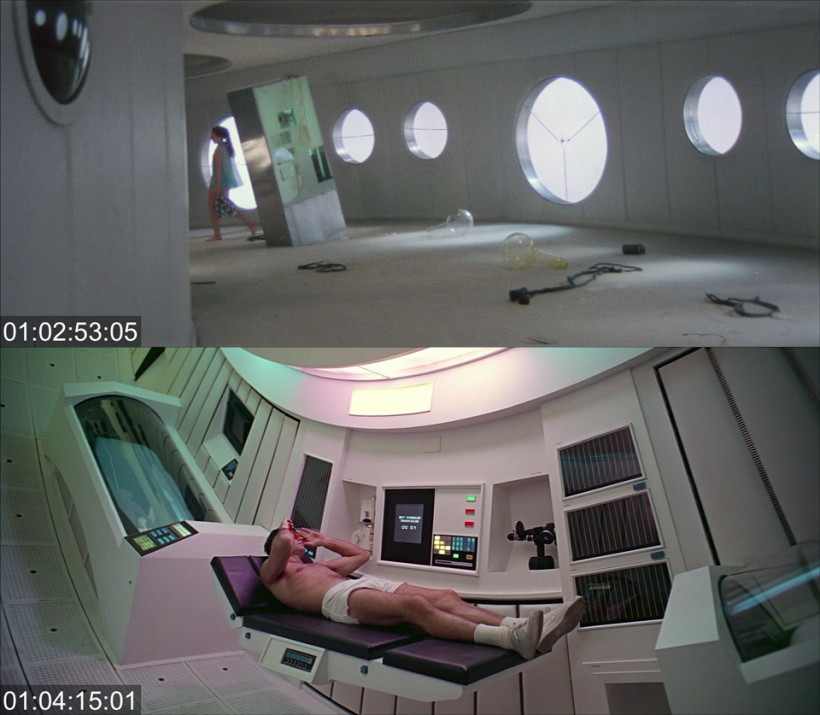
“What were you warning me about?”
At 1:06:00, Frank’s chess game against HAL and Dave’s subsequent conversation with HAL is matched by Kelvin’s second visit to Snaut. Not unlike Kubrick’s strangely deceptive chess game, Tarkovsky’s intentionally incongruent character blocking 17 seemingly drops hints as to the idea that something is not quite right. Dialogue and the generally unnoticed changing of set-pieces between recurring camera passes around the set in Solaris 18 seems to suggest that multiple scenes from Lem’s novel have been amalgamated into a single shot. These are important scenes for HAL in 2001 and so it is interesting to note this particular moment’s inclusion of a Soviet “thinking machine” computer on the set of Solaris 19 .
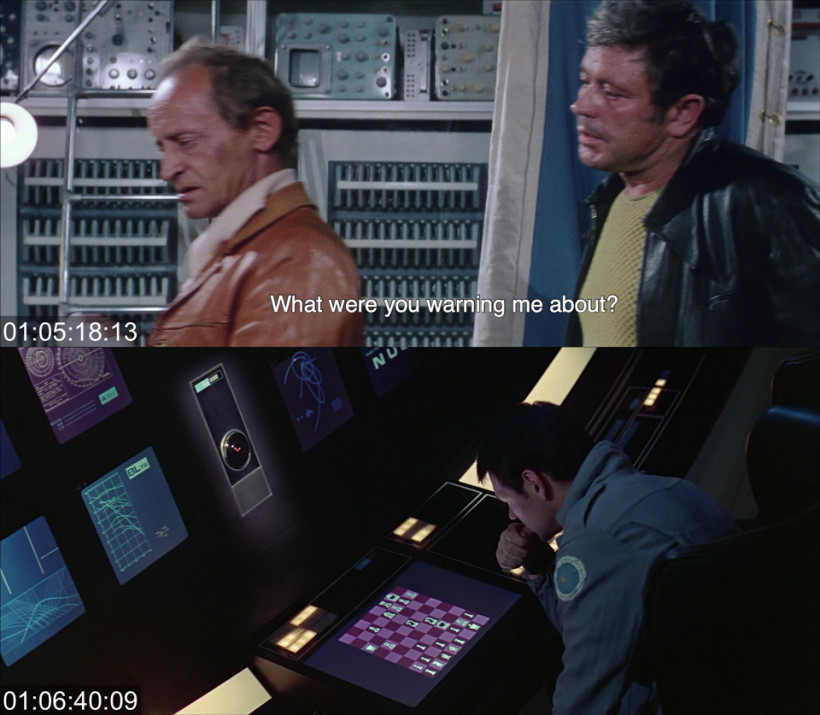
Dave’s personal conversation with HAL, and the remainder of Gibarian’s suicide tape follows. As Dave and Frank prepare for the first ‘E.V.A.’ spacewalk, Kelvin falls asleep in his room.
1:13:24, the first launch of a Discovery pod coincides with the arrival of the first Hari. Movements are carefully choreographed: camera zooms back / pod-bay door opens; camera pans across bed / pod moves forwards; Hari and Dave’s hands simultaneously move to screen-right; Hari and Dave’s pod rise and turn together. As Hari recognizes her own face in a mirror and Kelvin’s photo of her, the visor of Dave’s helmet turns black. Artemyev’s music for Solaris harmonizes here to the iconic air-flow & breathing sounds of 2001. To my mind, this is a most outstanding example of a polyphonic cinema, the films are truly dancing here.
1:18:48, no fault with the retrieved module, HAL must have a problem. Hari’s dress has materialized with a significant mistake: it can’t be opened.
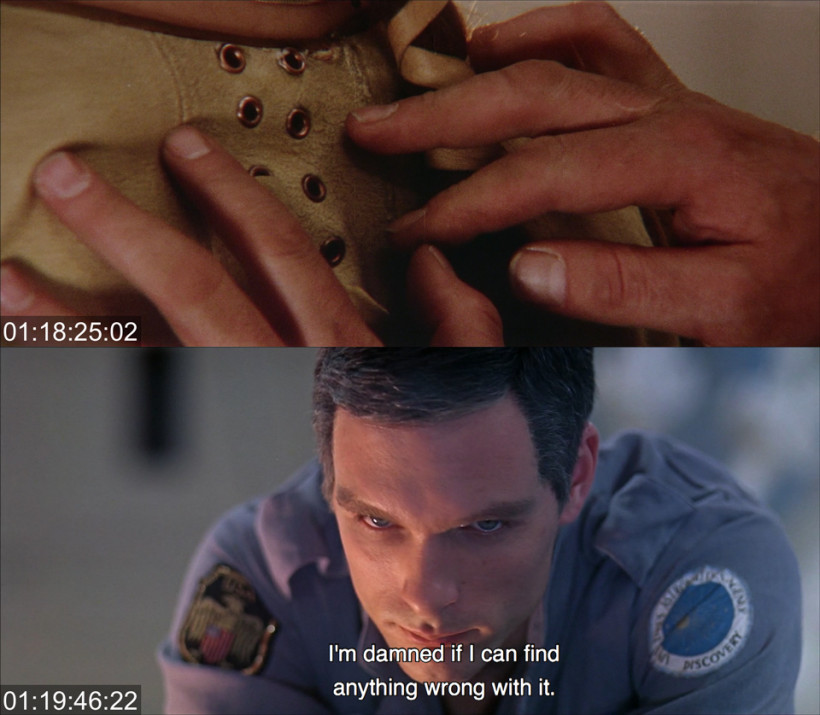
1:22:00, a message from earth and a chat with HAL. Kelvin launches rocket.
1:26:09, Frank and Dave’s private conversation. Kelvin and Snaut’s conversation.
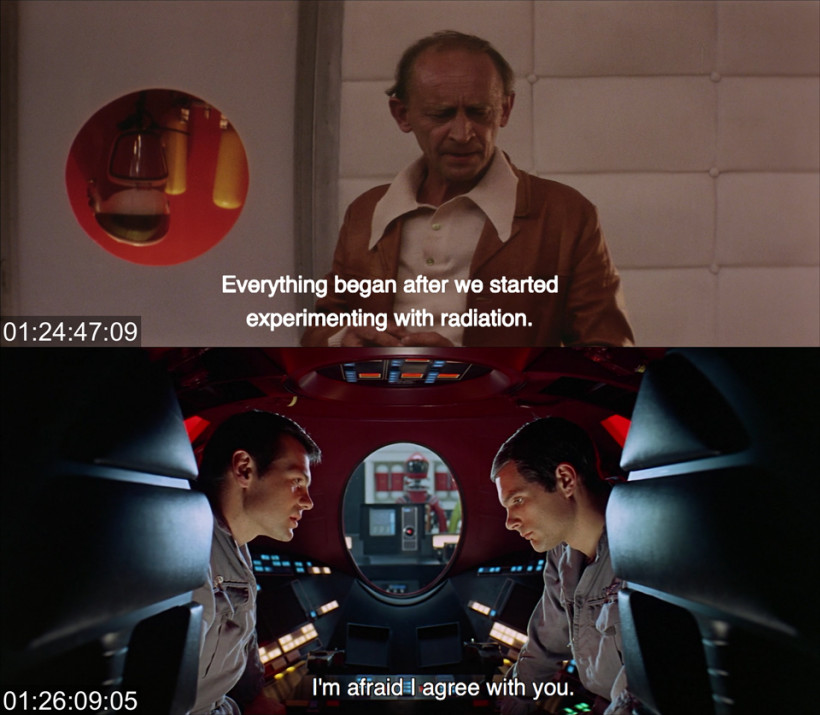
1:30:04, as a recapitulation, the second launch of a Discovery pod (Frank) coincides with the arrival of the second Hari. She embraces Kelvin at the same moment the pod controlled by HAL murders Frank. At a closeup to HAL’s pod-eye, Solaris’s camera moves up to Kelvin’s bed-light. Simultaneous hard-cuts: Frank falling through space with camera panning down – camera panning left-to-right in closeup across Solaris Station equipment. Panning is the same speed in both films, the shots end together.
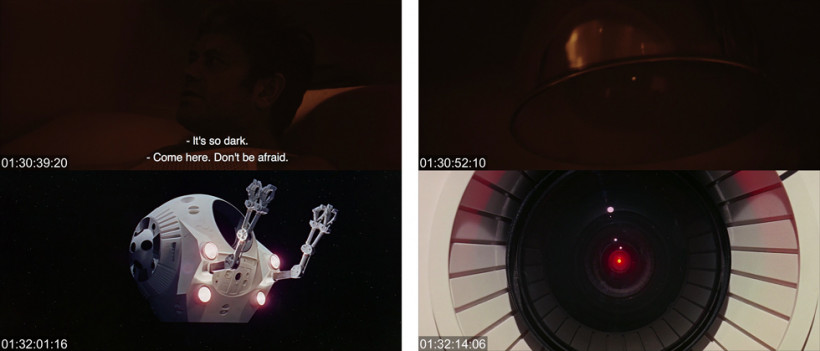
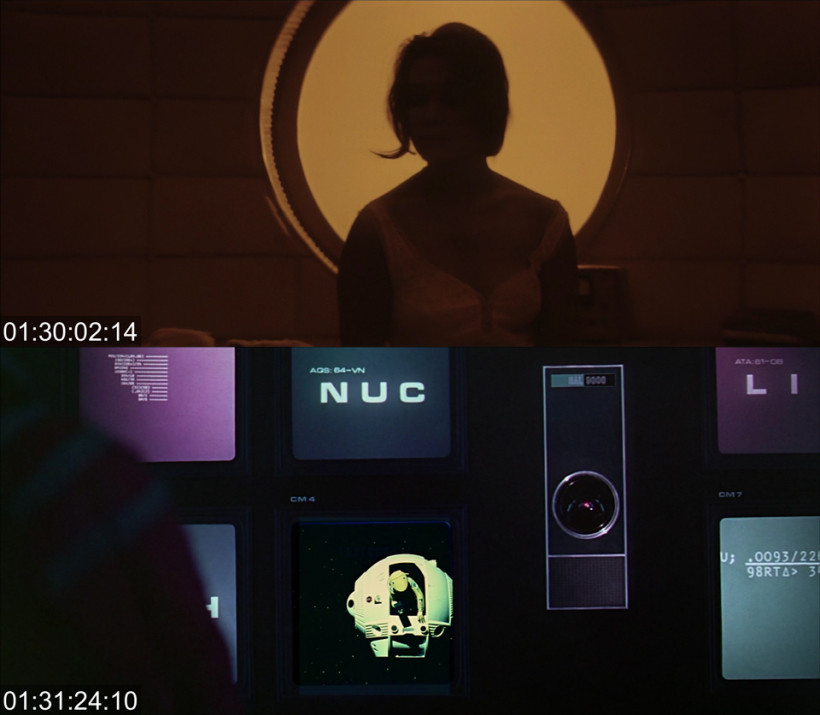
1:33:18, Hari’s break through the door and fall matches a ‘falling’ shot of Frank. The third pod launches as Hari regenerates from her mutilation. From here on, Hari’s yellow bedclothes and yellow dress matches Franks’ yellow spacesuit and Kelvin’s clothes match Dave’s pod. Over the next twelve minutes, episodes of an elaborate choreography is played out in which Kelvin and Hari are matched to the movements and shot compositions of Dave (in his pod) and Frank. One of the shots in Solaris is over two-and-a-half minutes long and features a moment when Dave’s pod grabs Frank while at the same time Kelvin grabs Hari. Concluding this section, at the point of Frank’s departure from the film, Hari now wears light-cyan bedclothes.
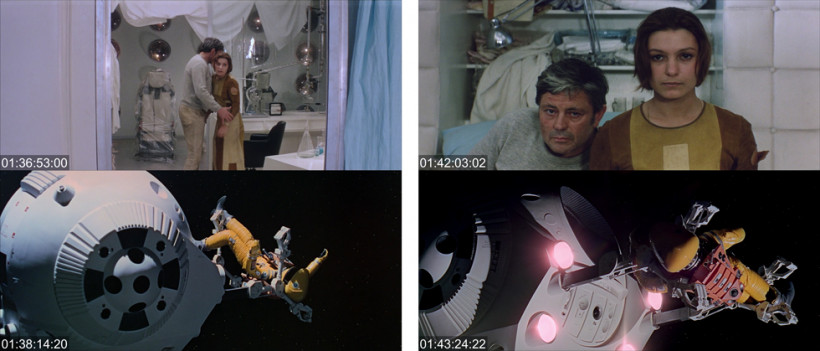
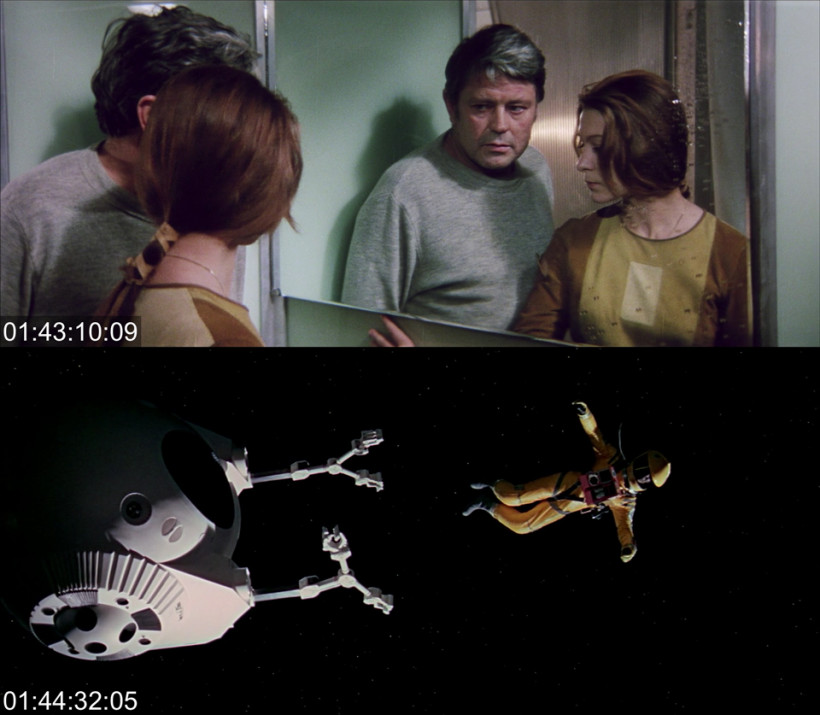
“I can barely hear you, speak louder”
At 1:34:55, a beeping sound from Dave’s pod instruments suddenly begins in 2001. This startles Hari, she looks over to Kelvin who picks up the phone. These are two rather dramatic and serious scenes – but together, there is a quite intentional joke in parody of Kubrick’s use of sound effects.
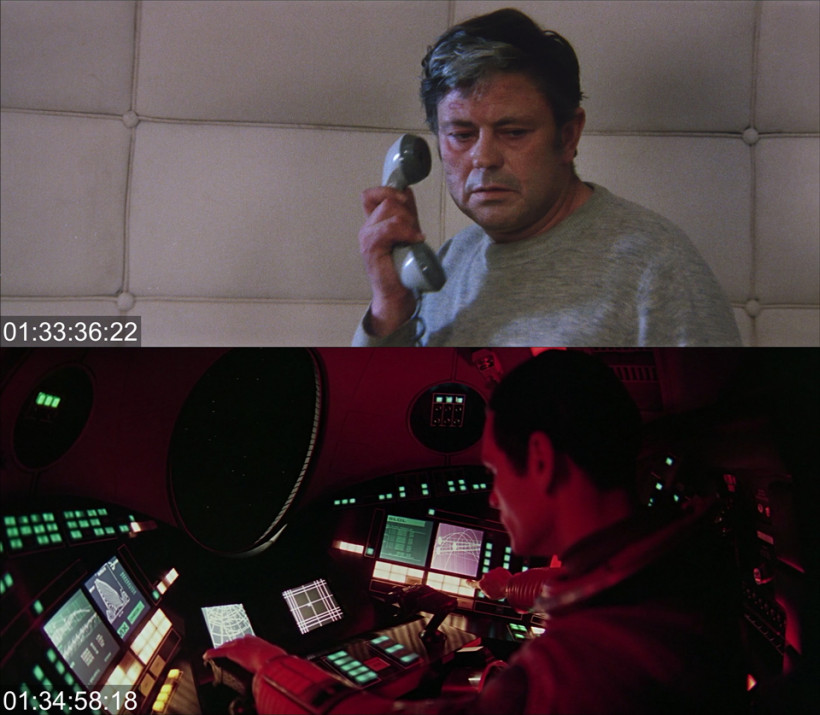
1:49:15, the effect of air rushing into the airlock after Dave closes the door sounds just like a toilet flushing. This cue is timed to Kelvin’s arrival in the shot from apparently having just used the toilet.
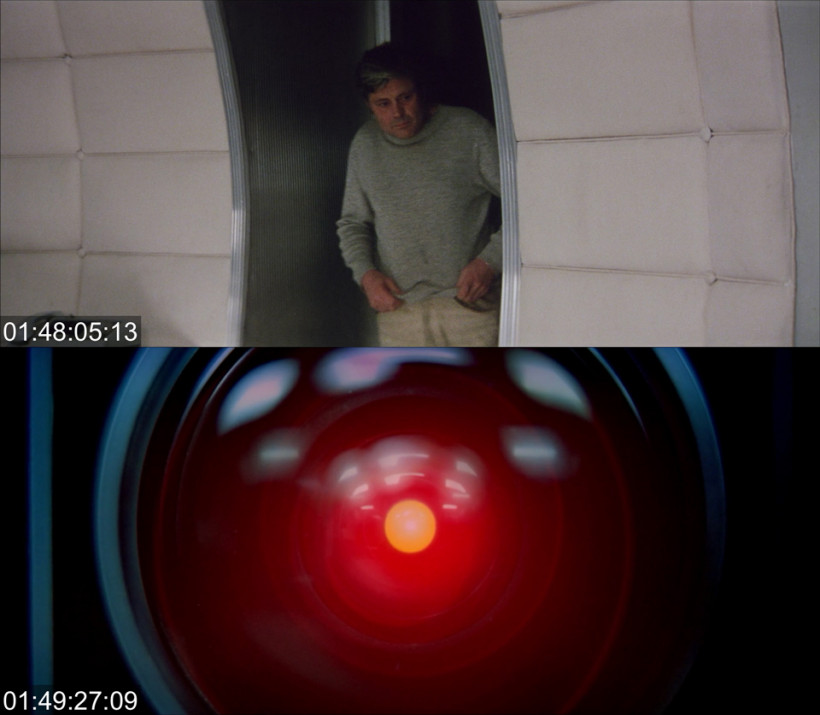
“Open the pod-bay doors please HAL”
1:40:25, the scene of Dave’s confrontation with HAL is set to Bach’s chorale. There is a return to the visual counterpoint of contrasting images as in the beginning of the films: nurturing vs. hostile environments. The cinematic poetry of how these sequences are audio-visually timed together between the two films is unmistakable.
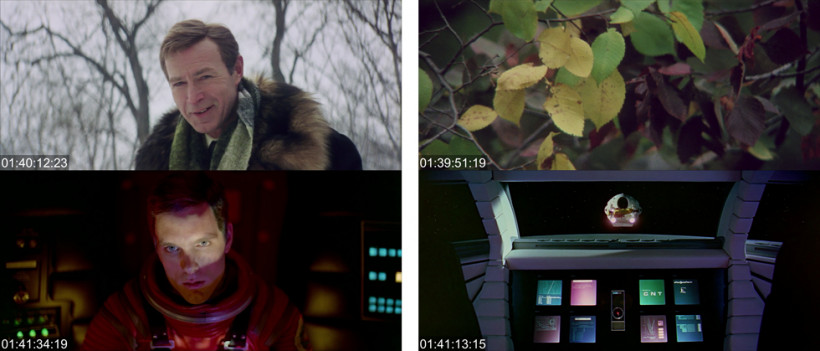
1:51:06, Dave enters HAL’s ‘Logic Memory Center’ to shut him down. This coincides with Hari’s crisis of memory. There is a remarkable symmetry of dialogue between HAL, Hari, and Kris.
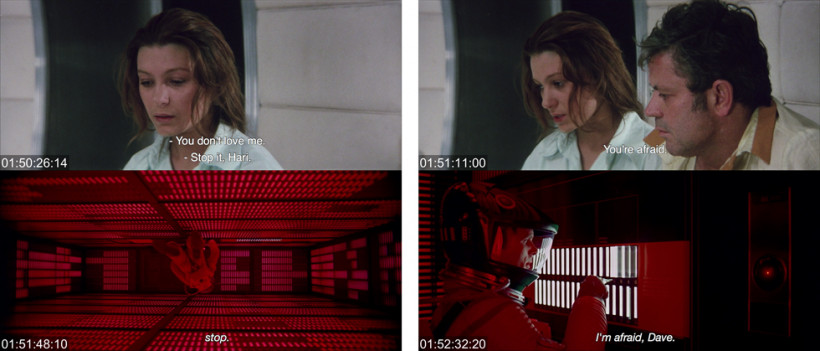
Jupiter and Beyond the Infinite begins at the same time as Snaut’s birthday party in the Library. A Bakhtinian idea of heteroglossia seem more pronounced from this point in Solaris through character dialogue, and even some snippets of folk-song when Snaut sings a German language parody of Oh! Susanna.
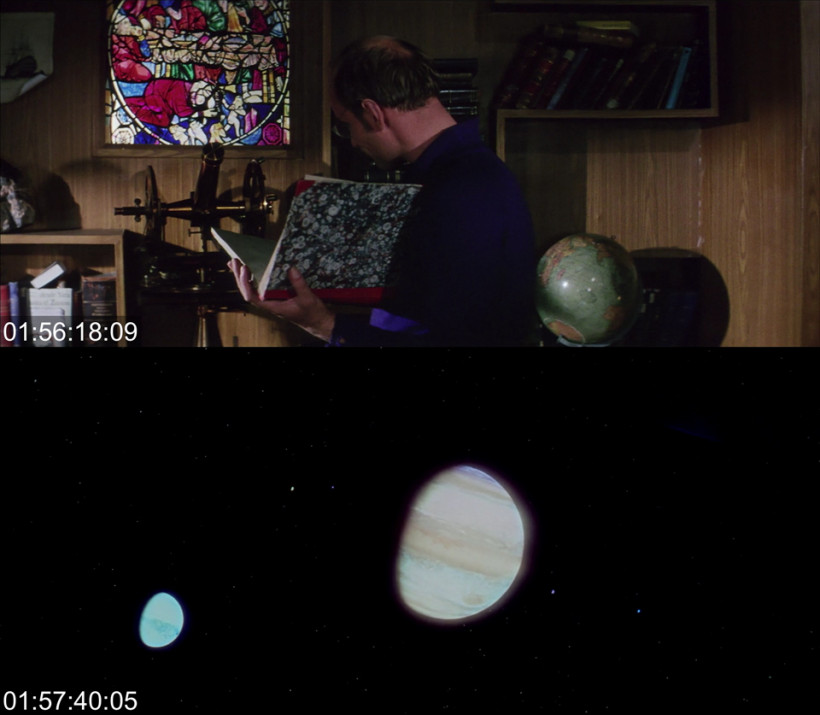
2001’s sneaky inclusion of a Christian cross symbol is here intertwined with Tarkovsky’s equally sneaky use of Gibarian as a Christ the martyr character.
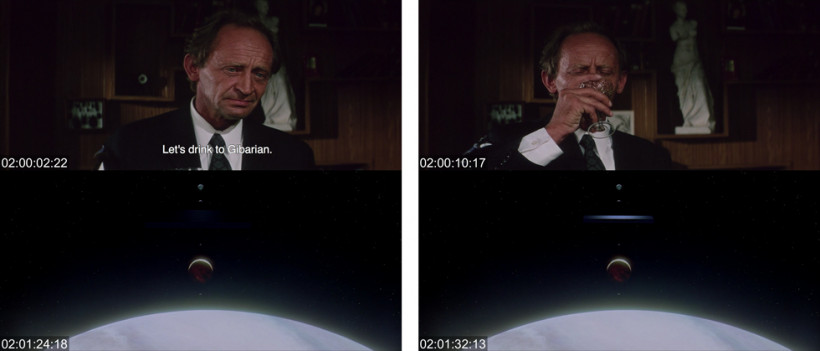
The Stargate / Library sequence is complex and multilayered; in part it reads like a history of modern art, complete with Cold-War-esque comparisons of abstraction and realism, and seeming reference to Walter Benjamin’s Art in the Age of Mechanical Reproduction (1935) also; there is a parallel process of transcendence – as it unfolds – depicted in the films’ opposed yet harmonized voice-ideas.
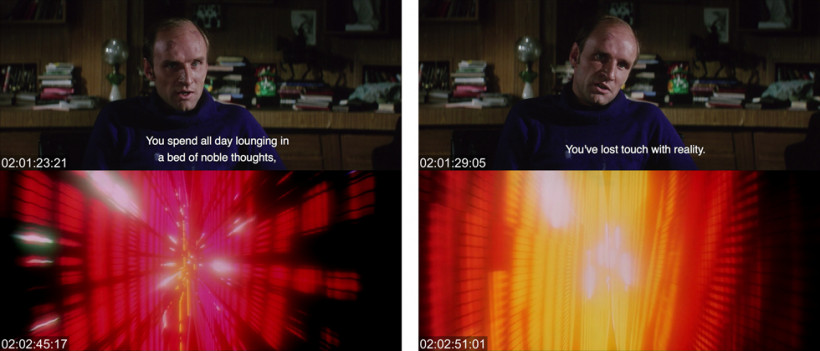
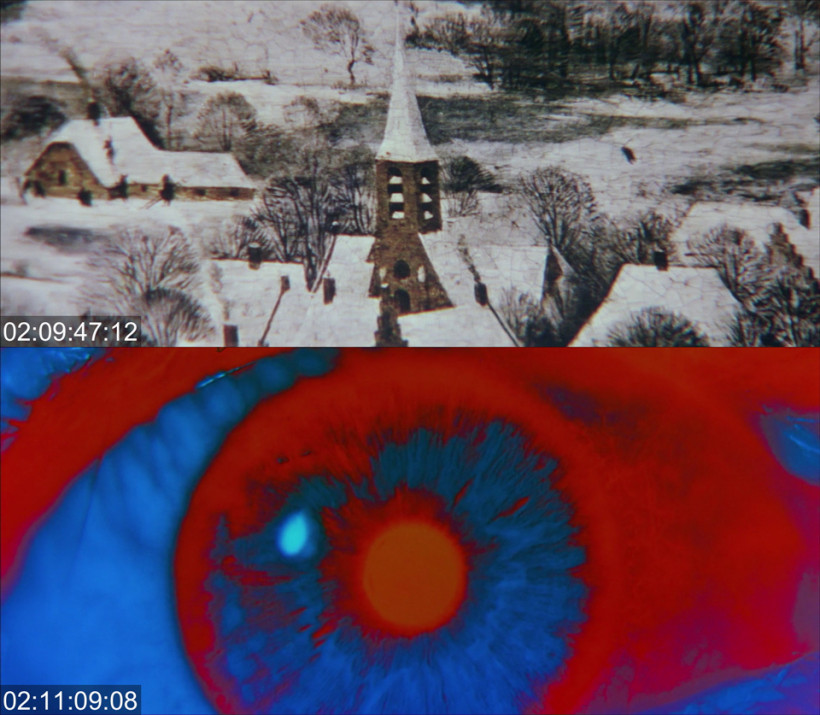
There would be a lot to say about the remainder of this ‘polyphonic-film’. From here I will mostly let the following still images speak for themselves and trust that the proposed structural principle of precision temporal matching has been adequately established for the moment.
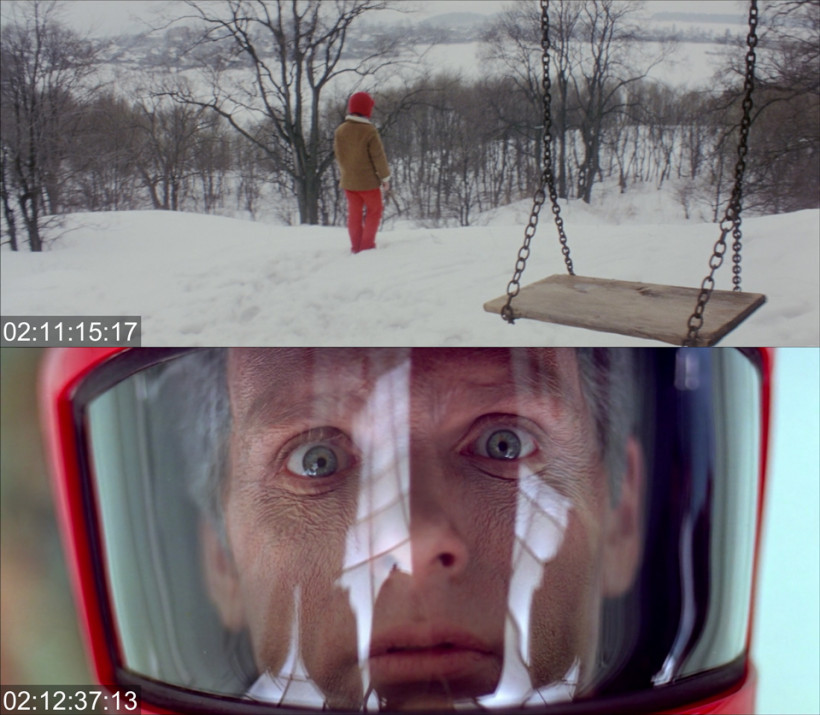
2:14:21, ‘Ladies and Gentlemen We are Now Floating in Space’. A series of matching camera movements feature background images of paintings.
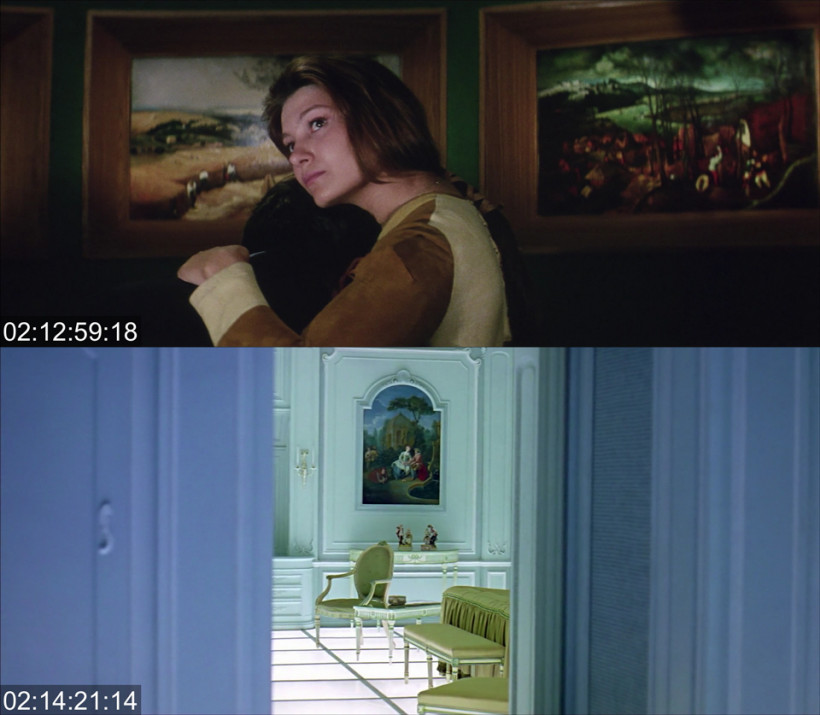
2:17:26, broken glass on the floor, in both films presumably referencing the irreversibility of time.
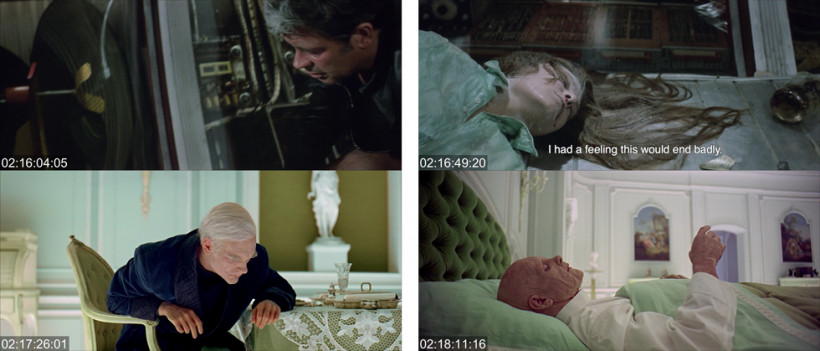

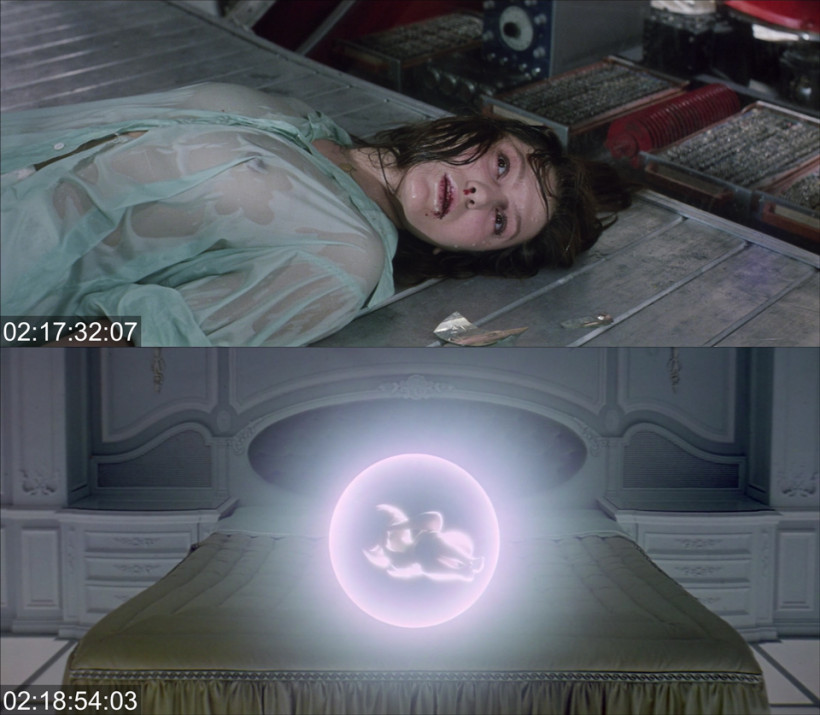
2:18:54, “At the Resurrection, sex will be abolished and nature made one. There will then only be man, as if he had never sinned”(Noble 215).
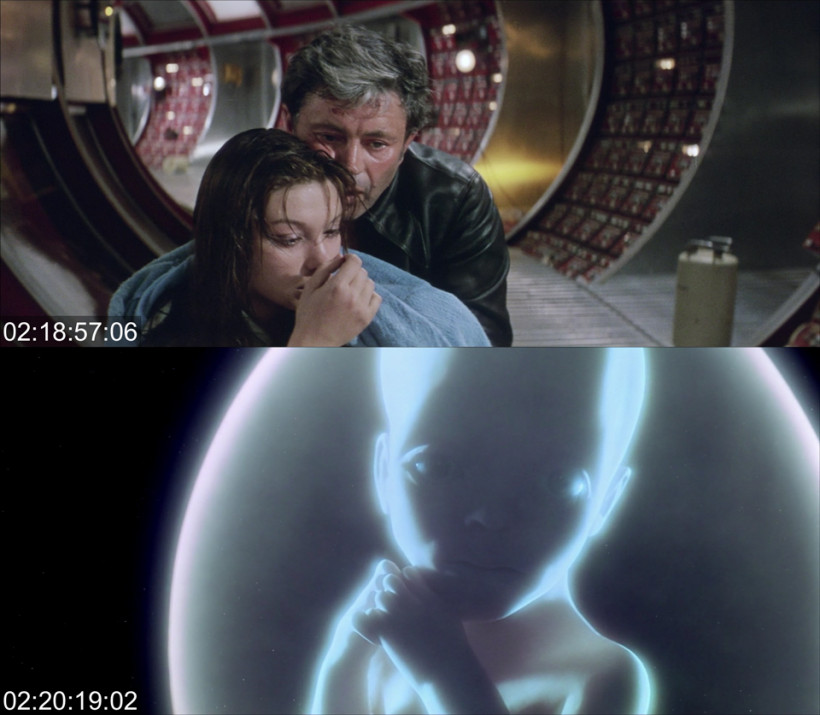
“All these heartbreaking lamentations are nothing but second-rate Dostoyevsky”
So why this extra (hidden) layer of temporal correspondence encoded within Solaris? There could of course be many reasons. One guess is that this structural principle exists as part of a strategy for embedding a greater dialogic depth to the work through means specific to the time-based potential of cinema. One summery of Bakhtin’s dialogism states:
The dialogic work carries on a continual dialogue with other works … and other authors. It does not merely answer, correct, silence, or extend a previous work, but informs and is continually informed by the previous work. Dialogic literature is in communication with multiple works. This is not merely a matter of influence, for the dialogue extends in both directions, and the previous work of literature is as altered by the dialogue as the present one is.” (Peters & Besley)
Eduard Artemyev has confirmed that Tarkovsky mentioned and quoted Bakhtin many times in their conversations; Bakhtin’s theories were to form a basis for Tarkovsky’s unrealized screen adaptation of Dostoyevsky’s The Idiot (Artemyev, 2022). It should be reasonable to speculate that references to Bakhtin appear in Tarkovsky’s other work. His use of parody seemingly speaks to this 20 , and there may be other hints in Solaris. Besides Dostoyevsky (and perhaps because of Dostoyevsky), Bakhtin gives special attention to Cervantes’ Don Quixote. Don Quixote is voiced in Solaris, most conspicuously when, on behalf of Snaut, Kelvin reads, “…there is only one bad thing about sound sleep, they say it closely resembles death”. Through a number of counterpoints earlier in the film, this allusion to brother gods Hypnosis & Thanatos (sleep & death) is bound to the voice-idea of Kubrick’s dreamless hibernating astronauts; and these men (who sleep through the film in their immortal sarcophagi) are synchronistically bound to Sartorius, his cold pragmatic scientific rationalism, his cruelty and Faustian character. Emotional death, emotional sleep, a condition that Kelvin ultimately transcends.
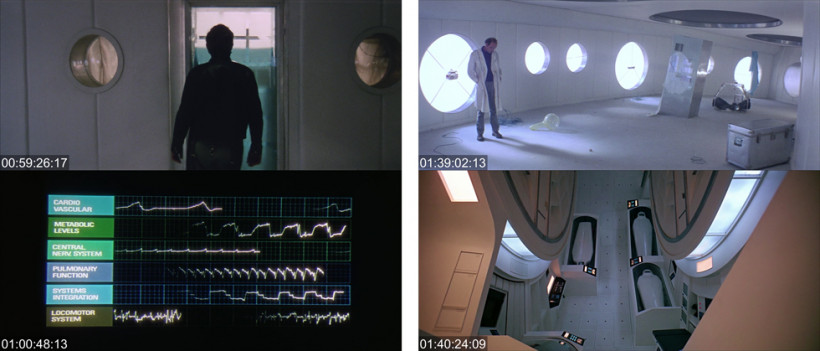
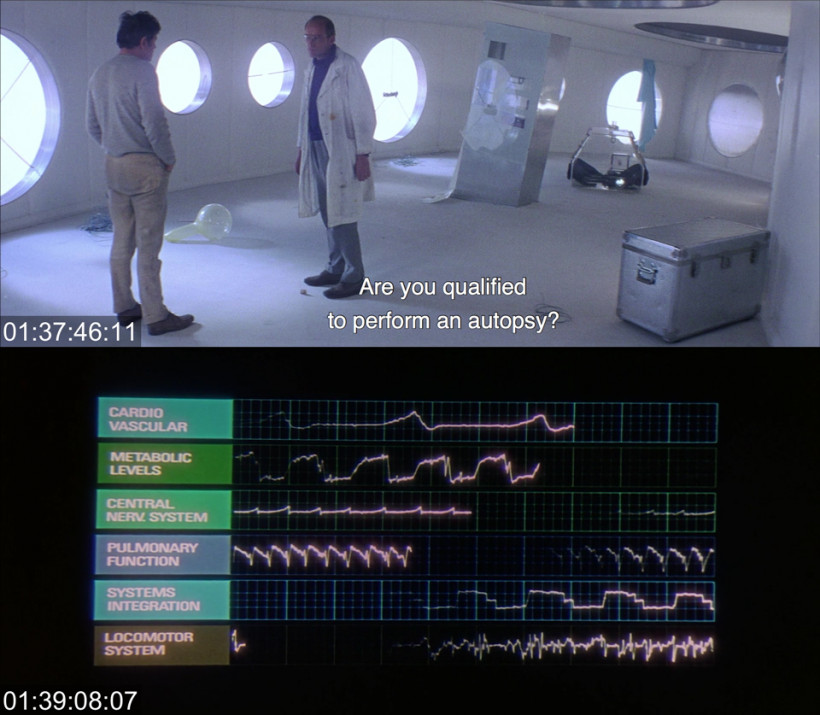
There could also be some quite practical reasons to adopt a pre-existing temporal schematic. One very powerful tool available to the artist is to adhere to a rigid structure of formal restraints. In the vertigo inducing limitless void that often enough defines artistic freedom, restraints help to give us a system: a map, a frame, a set of boundaries and rules to follow. It gives us something to react to, and when we are forced to break-the-rules, necessity reigns. Through longer running traditions and cannons of music, literature, painting, etc., meticulous adherence to, and variation of pre-existing formats is something of a constant.
In terms of time-based considerations, 2001 itself relied heavily on a progressively evolving ‘mixtape’ of preexisting music. Besides musical temp-tracks, Kubrick is known to have made enthusiastic use of Joseph Cambell’s monomyth as an overall binding narrative schematic 21 , and significant 2001 visual effects work is said to be based on the films of Pavel Klushantsev 22
“It’s like a charade that can be figured out only by those in the know.”(Artemyev, 2011)
Tarkovsky would seek to align the newly developing medium of cinema with greater established traditions of art, hence his instrumentalization of Bach, Bruegel, Cervantes, and other classics. The canonical employment of pre-existing structures is an important aspect of why certain classics resonate to the present day. Composer Edward Artemyev has related how Tarkovsky wanted to create in his viewers “a historic perspective into the depth of the centuries through the music and painting of the old masters so that they think of cinema as an old art that is 300 or 400 years old” (Artemyev, 2011). As theoretical expansion of traditional polyphonic music technique, Artemyev used the work of J.S. Bach as a kind of cantus-firmus: a fixed basis for which to build Solaris’s soundtrack. To explain observations of temporal matching between the films, we might speculate as to Tarkovsky’s use of 2001 as a conceptual / cinematic cantus-firmus, a foundation for which to ‘harmonize’ Solaris with an existing work.
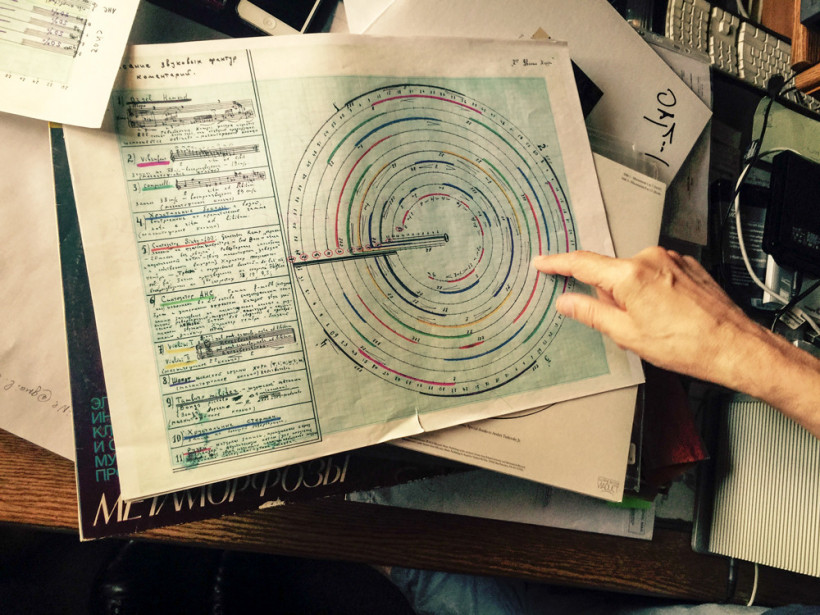
Edward Artemyev in 2017 showing a page from his score for Solaris’s music. Elements of J.S. Bach’s BWV 639 (used as a kind of cantus-firmus idea) is visible in Hammond Organ, vibraphone and other instruments. image credit: Dmitry Vikhornov
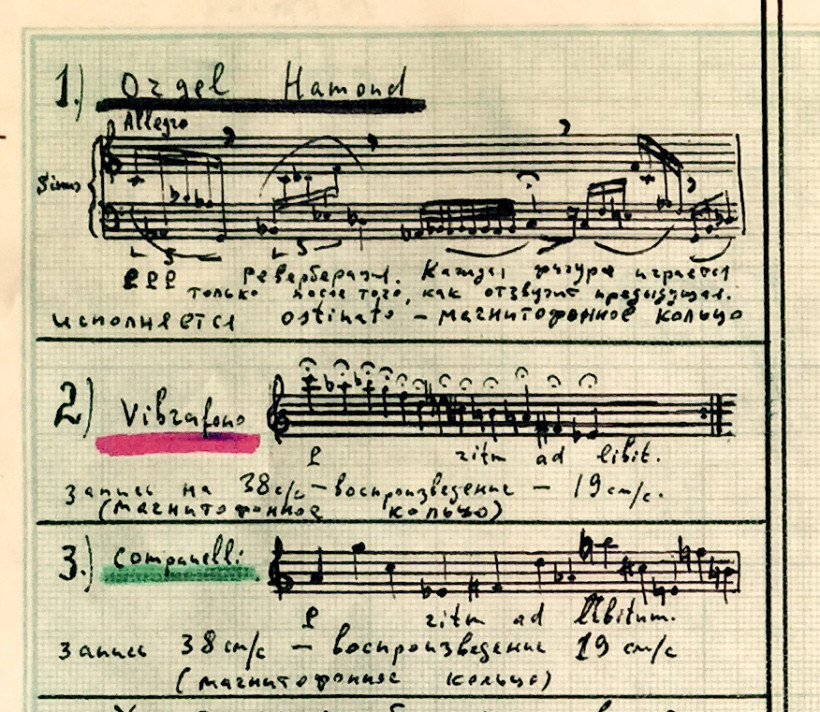
Solaris score detail. image credit: Dmitry Vikhornov.
“Bach used a technique from liturgical music of the Middle Ages called cantus-firmus. It’s a technique used in religious music … which uses a one-part Gregorian chorale as a foundation. Each of Bach’s famous organ preludes has this cantus-firmus, a theme from a Gregorian chorale, and on top of it he wrote his music. The theme served as an anchor to the new feeling added on top of it. What I did was I used Bach’s music as cantus-firmus and on top of it I wrote mine. I not only used the same technique as Bach, but also the same “technology.”
[…]
As a result of this work, a musical language was born that was used only by Andrei Tarkovsky. His three films were made in this manner, and it was never used again. It was as if I created this special musical language just for Andrei, for his method, his images, his vision of the role of music in cinema.
[…]
Each of his films is full of symbols and mythology. It’s like a charade that can be figured out only by those in the know. There is nothing accidental in his films, not even a pebble.” (Artemyev, 2011)
When departing from more obvious counterpoints, Solaris seemingly invites and rewards a game of ‘seeking out’ the more subtly stated instances of deliberate dialogism. As with Bach, certain “esoteric or highbrow cleverness” (Hofstadter 15), inventiveness, and humour in how Tarkovsky synchronistically harmonizes Kubrick becomes increasingly apparent. Here we can find echoes of certain ‘games’ within Bach’s polyphony: how Bach would encode fixed melodic subjects and countersubjects (in forms such as fugues and canons) through inversions, mirroring, time-transpositions, etc. to create structures of astonishing beauty and cohesion.
Contrapuntal Radio
Andrei Tarkovsky and the renowned Canadian Pianist Glenn Gould share some notable similarities, suffice to say they can be regarded as kindred spirits. 23 Gould enjoyed a certain popularity in the Soviet Union and Tarkovsky’s favourite record at the time of completing Solaris was said to have been “Bach’s D-minor piano concerto performed by Glenn Gould”(Fomina 91). Tarkovsky considered J.S. Bach to be the greatest of composers and he considered the deepest interpretations of Bach to be those of Gould(Artemyev 2022). It is interesting to speculate as to whether Tarkovsky had knowledge of Gould’s experimental radio documentaries – The Solitude Trilogy – most famously The Idea of North (1967). As inspired by the multi-voiced-ness of Bach’s music, these works employed the device of a kind of polyphonic layering of interviews into textures of spoken-word, and these were constructed with meticulous attention to detail. Gould’s “contrapuntal radio” would test the limits of his medium to a certain extent, and these experiments do seem to bare more than a passing resemblance to Tarkovsky’s “polyscreen cinema” approach as proposed here.
“For Each Instance an Elaborate System of Conventions”
Both a functional critique, and perhaps a cryptic acknowledgement of ideas in this essay can be found in Tarkovsky’s own words:
“Try to imagine a filmic spectacle shown simultaneously on several—even on six—screens. The movement of the film frame has its own nature, which is not that of the musical note; ‘polyscreen’ cinema should be compared not with a chord, or harmony, or polyphony, but rather with the sound produced by several orchestras playing different pieces of music at the same time. The only result would be chaos, the laws of perception would be broken, and the author of the polyscreen film would inevitably be faced with the task of somehow reducing simultaneity to sequence, in other words of thinking up for each instance an elaborate system of conventions. And it would be rather like putting one’s right arm all the way round one’s left ear in order to touch the right nostril with the right hand. Is it not better to accept, once and for all, the simple and binding condition of cinema as a succession of visuals, and to work from that starting-point? A person is quite simply not capable of watching several actions at once; it is beyond his psychophysiology. A distinction has to be made between those natural conditions which are immanent in the nature of a given art form—which define the difference between real life and the specific limitations of that art form—and illusory, artificial conditions which have to do not with basic principles but with slavish acceptance of received ideas, irresponsible fantasizing or the adoption of the tenets of related art forms.” (Tarkovsky 71)
Suppose for a moment that this is more than a preemptive dismissal of mere thought experiments into polyphonic cinema ideas. Tarkovsky tended towards writing from perspectives of first hand experience after all. From this passage, we might speculate that at some point Tarkovsky had actively engaged in multi-screen / polyphonic cinema experiments and come to the conclusion that, “once and for all”, they are not worth pursuing; that grafting principles of musical (or literary or painterly) theory onto the unique properties of the cinematic medium would irresponsibly ignore cinema’s defining limitations and deeper potential. One does get the impression he thought through such ideas – perhaps rigorously worked through such ideas before putting them aside to concentrate on aspects of the medium more integral to its inherent nature, its ability to engage with an audience, and to his aims as an artist.
Subversive Counter-Propaganda?
“Solaris was accepted without a single alteration. Nobody can believe it.” (Tarkovsky diaries 55) 24
The Soviet committees and censors were a force to be reckoned with. The initial green-light for Solaris was arguably part of a tit-for-tat Cold War Space-Race phenomenon, with an adequate response to the monumental efforts of Kubrick’s project being hoped for in Tarkovsky’s film. Not unlike 2001, the production of Solaris was provided with the advice of technical specialists. 25 Observed temporal locking between Solaris and 2001 may have (we can speculate) served in line with strategies for convincing the Soviet censors to let the film be released without significant changes – cuts would destroy the ‘fabric’, the musical-cinematic mechanisms of the film as an answer to 2001’s provocative message from the Americans.
“Design is design. Painting is painting. And a film is a film. One should ‘separate the firmament from the waters’ and not engage in making comic books.” (Tarkovsky; “Dialogue” 36, 37)
I have touched on a few interpretations of the remarkable gestalt which can arise from the synchronized side-by-side screening of Solaris and 2001: A Space Odyssey. Though astoundingly cohesive in terms of augmenting and transfiguring the compelling atmosphere of 2001, Tarkovsky’s polyphonic gestures overridingly amount to intense criticism of Kubrick work.
Although accepting of The Dawn of Man as “a fine piece of cinema”, Umberto Eco would sum up 2001’s puzzling finale as “a lot of pseudo-philosophical vagueness in which anyone can put the allegory he wants” (Eco 145). Indeed Kubrick would tend towards a more cryptic ‘open to interpretation’ strategy: standing for nothing while attempting to stand for everything. Through the lens of Tarkovsky however, Kubrick’s purported vagueness seems less of a problem – 2001’s artistic statements are clear enough – they are not a puzzle, but they add up to something of a totalist ideology that doesn’t make sense.
When we saw Kubrick’s movie, we were mesmerized by the film’s imagery, its expansiveness and space, the massive flying objects, and much more. But as for the scenes of the birth of humanity, his understanding of it was alien to us. They were logical for Kubrick’s interpretation, but for us who were inspired by different concepts, they could not serve as a good model… We chose a different approach that was true to the objectives and concepts of the film.” (Yusov)
More than fifty years later, it should be easy to criticize the premise of The Dawn of Man. Arguably based on Freud’s discounted assertions that our psychology is fundamentally based around an inherently aggressive human nature, we’re asked to believe in a chauvinistic socially-Darwinistic view of reality in which all technology, indeed anything identifiably human amounts to little more than the expression, repression, or sublimation of violence. 26 In Kubrick’s words: “Man’s whole brain has developed from the use of the weapon-tool. It’s the evolutionary watershed of natural selection… It’s simply an observable fact that all of man’s technology grew out of his discovery of the weapon-tool” (Kubrick; “In 2001”).
There seems more than a passing resemblance between the mythical prehistory of human / technologic progress invoked by Kubrick, and IBM’s contemporaneous efforts to effectively naturalize the computer in public consciousness. Through grand historic narratives placing computers at the pinnacle of ‘evolutionary progress’, IBM would run a decades long campaign to contextualize their technologies as paradoxically both ‘natural’ and ‘magical’ solutions to an environment which was physically and spiritually hostile to humans 27 . With his flash into the future, Kubrick’s “…computers and space suits designed by IBM engineers and their ever-present architectural consultants, 2001 presents, even fetishizes — with all of the paranoia implicit in the fetish — counterenvironmental technology. The plot of the film is quite simply the acceleration of technology to the point at which its nature as pure war is made explicit.” (Harwood 158)
In contrast to the more western models of technological transcendence and the primacy of instrumental reason, “Tarkovsky continues the traditions of Russian philosophy” in which “truth cannot be discovered in a purely intellectual way…and scientific achievements do not always bring benefits to man, and scientific intelligence, devoid of moral content, is destructive to all living things.” (Robertovna)
Romanticism
“If authenticity is being true to ourselves, is recovering our own ‘sentiment de l’existence,’ then perhaps we can only achieve it integrally if we recognize that this sentiment connects us to a wider whole. It was perhaps not an accident that in the Romantic period the self-feeling and the feeling of belonging to nature were linked.” (Taylor 140)
As a significant reaction to problematic aspects of Enlightenment thought, to neoclassicism, and to the First Industrial Revolution, historical Romanticism was formative to our modern sense of individualism (Taylor). To be sure, there is a lot to be said about Tarkovsky’s Romantic affinities. His commitments to sincerity and a personal sense of authenticity, medieval subject matter, and his particular approach to notions of realism are a few of the several hallmarks which attest to this in his films and writings. Though some critics would worry about a comparative ‘quaintness’ of critical style, suggesting that we consider Tarkovsky “subconsciously Bergsonian” in order to “salvage his theoretical musings from being dismissed as unembarrassedly Romantic or outdated” (Toymentsev 60), I find Tarkovsky’s manifestations of Romantic traditions as less problematic and more helpful to the understanding, framing, and contemporary significance of his work. 28 More useful than a preemptive dismissal of Tarkovsky’s Romantic leanings could be the investigation of a shared Romanticism implicit in both Bergson and Tarkovsky. Bergson’s delineations of ‘time’ and ‘duration’, with their kinship to Tarkovsky’s aesthetics (Totaro), could be explored “in connection with a possible heuristic fertility of the structural opposition between Enlightenment and Romanticism.” (Duarte 180)
Dialogues between Solaris and 2001 serve to frame Kubrick’s as a solidly neoclassical work 29 . Romantic era rejection and critique of the Enlightenment legacy of instrumental reason, particularly in how this is expressed through science & technology – humanity & nature seems embedded in Solaris. The film leans inwards, as in Romantic era quests for a deep spiritual authenticity. In contrast to this, and in light of its science-technology-industry boosterism, Kubrick’s vision becomes dialogically framed as neoclassical: its notions of authenticity aimed towards an unemotional sense of grandiose pictorial realism, its Greco-Roman thematics, its invocations of a morality grounded in ideals of heroic self-sacrifice for the great projects of civilization.
In testament to its neoclassical flavour, 2001: A Space Odyssey is at its core essentially a ‘Hero’s Journey’. Like Lucas and Coppola, Kubrick was a fan of Joseph Campbell’s ‘monomyth’ and would employ this more universalist approach to narrative structure within 2001, albeit with some clever reformulations. Kubrick’s hero is ‘Man’ and his journey stretches from “the desolate primordial wasteland to the utter void and abstraction of outer space” (Harwood 158), before his triumphant return home as a ‘master of both worlds’ in the form of the Star-Child. Conversely, Tarkovsky’s hero journeys inwards to confront a deeply personal reality. As marked by a melancholic wistfulness and introversion, Kelvin is confronted by emotional-moral-spiritual conflicts of quintessentially Romantic / Romantic-Naturalist sentiments.
The rescue of Bach’s music from obscurity in the Romantic era owes much to the voices of Goethe and E.T.A. Hoffmann, two important figures for Tarkovsky. Through these authors, Bach’s music takes on the character of spiritual transcendence on a deeply personal level, and with the structural (and ornamental) majesty of a Gothic cathedral. For Goethe, Bach’s music was received “as if it were the eternal harmony conversing with itself as it might have taken place in God’s bosom shortly before the creation of the world. I was deeply stirred, and it was as if I no longer had ears least of all eyes. I no longer possessed nor felt the need for any other sense organ” (Flindell 6). When Tarkovsky observes that “Bach’s D-minor choral prelude is realistic, because it expresses a vision of the truth” (Tarkovsky 154), we can assume this refers Romantic sentiments of an ‘inner truth’ 30 . To quote one of his many passages on the topic: “…an artist can discern the lines of the poetic design of being … going beyond the limitations of coherent logic, and conveying the deep complexity and truth of the impalpable connections and hidden phenomena of life … examining life beneath the surface… an organic link between the subjective impressions of the author and his objective representation of reality … authenticity and inner truth” (Tarkovsky 21).
Some central defining features of Bach’s music stem from principles of precise harmonic / temporal relationships: recursive (some might say ‘fractal-like’) isomorphic structural elements conversing across different timescales (Kaila). With this in mind, it’s interesting to think about how Bach’s music connects medieval, Renaissance, Baroque, Romantic, and contemporary eras; like a ‘time-crystal’, where diverse moments of history coexist simultaneously – resonate with each other – exist as intertwined, parallel (polyphonic) threads. A week after the final day of editing on Solaris, Tarkovsky writes: “I have been tormented by the certainty that the most extraordinary discoveries await us in the sphere of Time. We know less about time than about anything else” (Tarkovsky diaries 53).
In Tarkovskian terms, an individual has the personal capacity to observe the high ideal of a (Romantic) sense of inner truth; an artwork can, within it’s structural / conceptual cohesion have or reflect such a spiritual authenticity. While working on Stalker, Tarkovsky in his diary re-quotes Mahler: “‘Precision is the soul of the artist’s work.’…‘And anything that is not imbued with that supreme craftsmanship is doomed to die before it even sees the light of day!’…‘In Bach all the vital seeds of music are brought together, like the world in God. Nowhere else has there ever been such polyphony!’…‘Such polyphony is an unheard-of miracle not merely for his time, but for all times.’” (Tarkovsky diaries 145, 146).
Conclusion
“I have finished my Solaris. It’s more harmonious…” (Tarkovsky diaries 53)
Tarkovsky’s ‘polyphonic harmonizing’ of Solaris to Kubrick’s 2001 is a remarkable artistic achievement. For a film to stand on its own as well as it does, and yet have been made with such a precise, aesthetic, and all-encompassing level of close-nit intertextual dialogue with another film – as an idea, it’s certainly clever – in terms of execution, I’d venture to say it’s closer to ‘genius’. For this essentially hidden layer in his work, Tarkovsky explored and developed novel conventions of ‘cinematic counterpoint’, observations of which suggest his employment of strict formal restraints in terms of shot composition and temporal structure on larger and smaller timescales in his film. 31
Solaris’s particular use of Bach’s F-minor choral prelude as a kind of cantus-firmus, a foundation for Artemyev’s music, suggests that the idea of using 2001 as a ‘fixed melody’ to be harmonized into of a work of polyphonic cinema would be conceptually congruent. As seen through the lens of historical Romanticism, Bach’s music embodies the central themes of Solaris on an axis that is technical, moral, spiritual, temporal, and personal. Historical Romanticism was a portal of Bach’s music into modern consciousness, and it’s traditions form important threads in Trakovsky’s films and writings.
In addition to Bach and uses of audiovisually polyphonic technique, Tarkovsky’s references to Dostoyevski and Don Quixote would seemingly signal inspiration from Bakhtin’s concepts of dialogism and polyphonic-novel. Through notable uses of parody, heteroglossia, and counterpoint, Solaris serves to reframe 2001 as phony, cynical, and morally corrupt. Though Tarkovsky’s polemics may seem harsh, the effect of his polyphonic approach is to elevate Kubrick.
Kubrick’s film situates itself within the theological construct of Man’s cyclical ‘great-leap of progress’ as guided by the God-of-Technology in a mechanized universal order. 32 As a monolithic / monologic monument, 2001 attempts to brand cinema as a catalyzing force in a fantasized transcendent millennial jump of evolution, away from the fetters of our earthbound bodily cages, and towards a destiny greatness in Man’s deification: an age old aspiration for reunification with God. Through Solaris and its polyphonic strategies, Tarkovsky would attempt to create a selectively reflective mirror, a 180-degree phase-inverted signal to cancel out the Faustian scientific hubris of Kubrick’s vision, to manifest confrontation with the pain and beauty of our physically / spiritually earthbound souls, and enact the importance of art, tradition, and nature.
“Take-home message: ‘There’s no point in humanity dragging its shit from one end of the galaxy to the other.’” (Tarkovsky diaries 50)
Appendix
Reconstructing the side-by-side composite of 2001 and Solaris used for this study can be done by observing the following details. Alternately, a ‘Premiere Pro’ or XML file + instructions can be found here: http://recordingmedium.com/_solaris2001/
Synchronization
I used the Criterion Collection Blu-ray release of Solaris and a the remastered Blu-ray release of 2001. The frame-rates of both films are 23.976 frames/second(fps). With this combination, Solaris should begin rolling at 00:01:21;20 (00hours:01minute:21seconds;20frames) 2001-time which results in the first hard-cuts of both films being frame synchronized at 00:03:34;06 Solaris-time and 00:04:56;02 2001-time. Care should be taken to not mix different framerates, e.g. 25fps or 29.97fps as can be found on some DVD or VHS releases.
Small differences of about half-a-second exist between different releases of 2001 owing to variations of the beginning point of introduction music prior to The Dawn of Man and after the intermission. I made no cuts or other temporal adjustments after aligning the opening shots for my analysis, but to account for any variations in different releases, my chosen synchronization point after 2001's intermission places the first frame of picture of the 2nd part (Discovery spaceship) at 01:28:41;17 Solaris-time. My assumption is that Tarkovsky worked with a ‘road-show’ release print of 2001, spliced together as it would have been delivered. Differences of +/- one second are not particularly critical to the enjoyment of a side-by-side screening, however, since Solaris appears to have provided enough clues for frame-accurate alignment, before and after 2001’s intermission, precise synchronization points become obvious and helpful.
Audio
2001’s (black screen) opening music, Ligeti’s Atmosphères, should be cross-faded into J.S. Bach’s BWV 639 introduction to Solaris. The Richard Strauss fanfare Also Sprach Zarathustra should best be left out. Likewise, Johann Strauss’ An der schönen blauen Donau is also best left out of a side-by-side screening. 2001 tends to be mastered much louder than Solaris, so care should be taken to balance the audio so that both films can be heard. With the exception of Strauss and Strauss, the soundtracks of both film compliment each other very well. Choosing to minimize and/or remove the sounds of the monkeys makes for a more aesthetically pleasing experience.
Other Notes
In a side-by-side screening, 2001 ends some 20 minutes before Solaris. Besides Tarkovsky presumably forbidding Kubrick to have the last word, there should be plenty of interpretations as to why this is the case in a polyphonic-cinema reading. 2001 cuts off with a birth / rebirth, Solaris seemingly attempts to carve deeper into the disorientation, pain, transcendence, and redemption implied in its notions of birth / rebirth / death, and first steps into a new reality. Also interesting to note is the fact that the bulk of ‘deleted scenes’ from Solaris would have been situated after the 144 minute end point of 2001.
Acknowledgements
Masha Domracheva, Dmitry Vikhornov, Anika Schwarzlose, Alva Imhotep, Aaron Schuster, Eduard Artemyev, Temo Dou, David Hoffos.
––––––––––––––––––
Bibliography:
Alexander, G. & Brown, T.E. “Gaffes & Glitches in 2001”. http://www.visual-memory.co.uk/amk/doc/gaffe.html. Accessed 12/01/2022.
Artemyev, E. Interview, 2011, Criterion Collection, Solaris DVD extras.
Artemyev, E. Telephone conversation with the author (Masha Domracheva as interpreter). February, 2022.
“Auteur in Space; Tarkovsky, Solaris, and the Unknown”, 2015. http://kogonada.com/portfolio/auteur-in-space. Accessed 12/01/2022.
Bakhtin, M. “Discourse in the Novel”, 1975. The Dialogic Imagination; Four Essays by M. M. Bakhtin. Holquist, M. ed. 1981, University of Texas Press.
Cavedo, K. “Alien Encounters and the Alien/Human Dichotomy in Stanley Kubrick’s 2001: A Space Odyssey and Andrei Tarkovsky’s Solaris”. 2010, Scholar Commons.
Cima, A. “Road to the Stars – 1957 Soviet Space Vision with Stunning Special Effects”, 2011. https://www.candlelightstories.com/2011/01/19/road-to-the-stars-1957-soviet-space-vision-with-stunning-special-effects/. Accessed 12/01/2022.
Duarte, L.F.D. “Romanticism and holism in the anthropology of the West (revisiting Bergson’s paradox)”. Anthropological Theory. June, 2015. pg 179-199.
Eco, U. “The Multiplication of the Media”, 1983. Faith in Fakes; Travels in Hyperreality. 1986, Minerva.
Efrid, R. “Solaris and the Chiasmic Image”. Refocus; The Films of Andrei Tarkovsky. Toymentsev, S. ed. 2021, Edinburgh University Press.
Flindell, E.F. “Bach and the Middle Ages”. Bach, Vol. 36, No. 2 (2005), pp. 1-119.
Fomina, N. “Costumes for the Films of Andrei Tarkovsky”, 2016, Cygnet.
Gallagher, P. “Before 2001 – Pavel Klushantsev’s Classic Science Fiction Film ‘The Road to the Stars’”, 2011. https://dangerousminds.net/comments/before_2001_pavel_klushantsev_classic_road_stars. Accessed 12/01/2022.
Gilbert, J. “Auteur with a Capital A”. Stanley Kubrick’s 2001: A Space Odyssey; New Essays, Kolker, R. ed. 2006, Oxford University Press.
Guidry, K. “Watch: Video Essay Details How Andrei Tarkovsky’s Solaris Is A Response To Stanley Kubrick’s 2001: A Space Odyssey”. 2015.
https://www.indiewire.com/2015/08/watch-video-essay-details-how-andrei-tarkovskys-_Solaris_-is-a-response-to-stanley-kubricks-2001-a-space-odyssey-260934/. Accessed 12/01/2022.
Harwood, J. “The Interface; IBM and the Transformation of Corporate Design; 1945–1976”. 2011, University of Minnesota Press.
Hofstadter, D.R. “Gödel, Escher, Bach: an Eternal Golden Braid”. 1979/1999, Basic Books.
Kosulin, V. “The energy of delusion. Tarkovsky and Kubrick”, 2020. https://www.peremeny.ru/blog/25216. Accessed 12/01/2022.
Kubrik, S. “In 2001, Will Love Be a Seven-Letter Word?”. Interview conducted by William Kloman, New York Times Film Review, 1968. https://archive.nytimes.com/www.nytimes.com/library/film/041468kubrick-2001.html. Accessed 12/01/2022.
Kubrick, S. “Playboy Interview: Stanley Kubrick; A candid conversation with the pioneering creator of 2001: A Space Odyssey, Dr. Strangelove and Lolita”, interview conducted by Eric Norden. Playboy. September, 1968. https://scrapsfromtheloft.com/2016/10/02/playboy-interview-stanley-kubrick/. Accessed 12/01/2022.
Noble, D.F. The Religion of Technology; The Divinity of Man and the Spirit of Invention. 1997, Penguin.
Paulus, I. “Stanley Kubrick’s Revolution in the Usage of Film Music: 2001: A Space Odyssey (1968)”. International Review of the Aesthetics and Sociology of Music. June, 2009. pg 99-127.
Patterson, D. “Music, Structure and Metaphor in Stanley Kubrick’s “2001: A Space Odyssey”“. American Music. Autumn, 2004.
Peery, A. “Stanley Kubrick’s 18th Century: Painting in Motion and Barry Lyndon as an Enlightenment Gallery”. Scholars: The McKendree University Journal of Undergraduate Research. Winter, 2017.
Peters, M.A. & Besley, T. “Models of Dialogue, Educational Philosophy and Theory”. https://doi.org/10.1080/00131857.2019.1684801
Robertovna, T.M. “Confrontation of Scientific Reason and Nature in the Film Solaris”. International Scientific Conference «Social and Cultural Transformations in the Context of Modern Globalism. 2020, EpSBS.
Robinson, J.M. The Sacred Cinema of Andrei Tarkovsky. 2006, Crescent Moon Publishing.
Romadin, M. Interview, 2011, Criterion Collection, Solaris DVD extras.
Sargsyan S. “С Андреем Тарковским” / “With Andrei Tarkovsky”. http://tarkovskiy.su/texty/vospominania/Sarkisian.html. Accessed 12/01/2022.
Tarkovsky, A. “Dialogue with Andrei Tarkovsky about Science-Fiction on the Screen.” Interview conducred by Naum Abramov. Andrei Tarkovsky Interviews, Gianvito, J ed., 2006, University Press of Mississippi.
Tarkovsky. A. Letter to the Department of Culture of the CPSU on October 20, 1970. http://tarkovskiy.su/texty/Tarkovskiy/pisma.html. Accessed 12/01/2022.
Tarkovsky, A. Sculpting in Time. 1987, University of Texas Press.
Tarkovsky, A. Time Within Time; The Diaries 1970-1986. 1994, Faber and Faber.
Taylor, C. The Malaise of Modernity, 1991, House of Anansi Press.
Totaro, D. “Time and the Film Aesthetics of Andrei Tarkovsky”. Canadian Journal of Film Studies. March, 1992. pg 21-30.
Toymentsev, S. “Does Tarkovsky Have a Film Theory?”. ReFocus; The Films of Andrei Tarkovsky. Toymentsev, S ed. 2021, University of Edinburgh Press.
Yusov, V. Interview, 2011, Criterion Collection, Solaris DVD extras.
Žižek, S. “The Thing from Inner Space”. Lacanian Ink. September, 1999. https://www.lacan.com/zizekthing.htm. Accessed 12/01/2022.
Zubacheva, K. “In a country far, far away… How did a filmmaker in the USSR inspire Hollywood blockbusters?”, 2017. https://www.rbth.com/arts/327087-soviet-filmmaker-hollywood. Accessed 12/01/2022.
https://en.wikipedia.org/wiki/Mystery_Science_Theater_3000. Accessed 12/01/2022.
“2001: A Space Odyssey Hero’s Journey”. https://www.shmoop.com/study-guides/movie/2001-space-odyssey-movie/analysis/heros-journey. Accessed 12/01/2022.
Notes
- see Kosulin. ↩
- Although Tarkovsky would ultimately favour avoidance of problematic “simultaneity” within an imagined “polyscreen cinema”, it seems that his conclusions may have emerged from an active theory-based and practice-based experimentation into polyphonic directions. In the context of a hypothetical polyphonic cinema, when he asserts (more than ten years after completing Solaris) that the nature of the cinematic frame is “not that of the musical note”, we might suppose such musical analogies were seriously investigated. When Tarkovsky rejects “adoption of the tenets of related art forms” such as literature, music, or painting, to conclude that “cinema as a whole is still looking for what determines it”, it may be illustrative to presume that he experimented with a number of different theoretical and practical models in the production of his works. Tarkovsky declared it to be “all-important that the interaction between cinema and literature should be explored and exposed as completely as possible, so that the two can at last be separated, never to be confused again.”(Tarkovsky, 1987, p. 71, 173, 60) ↩
- For 2001, “the director made a long search for the music: as in his earlier movies, he used the music at the set and he used pre-recorded temporary music (so called temp tracks) during the editing”(Paulus 99). See also Patterson. ↩
- Though parody of 2001 is a necessarily deadpan form of humour embedded within Solaris, the format of temporally superimposed heckling, wisecracks known as “riffing”(wikipedia), is foundational to Mystery Science Theatre 3000 whose use of humour also provides a distancing effect. ↩
- Stills are here taken from a time-locked composite of the two films. The time-codes are all 00:01:21;20 (1minute:21seconds:20frames) offset due to temporally aligning the opening shots of both films (see appendix). ↩
- All times are cited in 2001 time. ↩
- One can read speculations as to the horse’s role in the film as a projection of Kelvin’s psychology, but more likely is the idea that it’s just a horse. ↩
- Kelvin enjoys shelter by allowing himself to get drenched. He can and does manage to towel-off inside the house at his leisure. Kelvin’s father merely steps inside before the torrent while the children, caught unaware, run through the rain to the bridge for shelter. ↩
- Der Schweigende Stern (Kurt Maetzig, 1959) is another East-Bloc sci-fi film based on a Stanisław Lem novel which makes special mention of the American (atomic) bombing of Hiroshima. It’s a foundational part of the film but was all but removed from a recut American release of Maetzig’s film. ↩
- Tarkovsky’s much discussed City of the Future sequence is often compared to Kubrick’s Stargate sequence. Though a visual-rhyme of perspective and movement certainly exists between these scenes, City of the Future better matches Kubrick’s moon-lander sequence with its temporally matched beginning, ending, duration, pacing, colour-scheme and narrative function. Many shot-for-shot temporal counterpoints exist between these two sequences also. ↩
- The alternate use of black-and-white and colour sections of Solaris have presented something of a riddle because, “the use of colour is not tied in to the psychological narrative in the film, as it would be in Mirror and later films, and the switches to black-and-white seem somewhat arbitrary” (Robinson 372). Some switches between black-and-white, colour, and monochrome film in Solaris may have been informed in part by the idea of contrapuntally matching shots to 2001. ↩
- This cut is acknowledged as a significant gesture in Solaris where, “…sound and movement suddenly ends (one of the most delicious shots in Tarkovsky œuvre)” (Robinson 378), and is, “… one of the few examples of Tarkovsky using expressionistic editing … justified because the stark contrast between the chaotic time-pressure in the technological montage and the tranquil rhythm in the shot of the natural landscape reflects one of the film’s thematic conflicts of technology/nature, space.” (Totaro 25) ↩
- In addition to the Earth-phase error, wires attached to Bowman’s feet are said to be visible in one scene (Alexander & Brown) and it is a this (01:16:07) moment we get a closeup of Hari’s feet. ↩
- The role of Gibarian had originally been earmarked Armenian film director Sergei Parajanov, but he is said to have gifted the part to Sargsyan. In preparing Sargsyan for the role, Tarkovsky noted that: “Gibaryan, among other things, yearns for his homeland, and we tried to surround him with all sorts of things that remind him of Armenia, its churches and nature. He also took Armenian cigarettes with him” (Sargsyan). When discussing criticism for having no clear reason for turning Lem’s Gibarian character into an Armenian, Tarkovsky told Sargsyan: “I needed an Armenian. Period.” (Sargsyan). Owing to their roles as important Armenian cultural figures, the graves of Khachaturian, Sargsyan, and Parajanov lay a few metres from one another at the Komitas Pantheon in Yerevan. Aram Khachaturian’s brother Emin Khachaturian conducted the music of many Soviet era films in including Stalker (1979) ↩
- The Armenian religious structure in the adjacent picture shown in the same book could be a detail of the church of St. Gayaneh or Etchmiadzin Cathedral, but thus far I have not been able to identify it. ↩
- In his book “The Religion of Technology; The Divinity of Man and the Spirit of Invention”, David F. Noble maps out the inherent Christian millennialism underwriting the epic development and contemporary expressions of western science and technology. Though he makes no mention of Kubrick, it’s interesting to note that the book’s three primary examples of contemporary science: space-travel, artificial intelligence, and genetic engineering are foundational to the puzzling utopian vision of 2001. Notwithstanding Kubrick’s apparent criticism of AI in the film, the technology of HAL presents as something of a necessary catalyst to Man’s imagined ‘great leap’ forwards. Through the lens of Noble’s thesis, Kubrick’s (and Clarke’s) Star-Child makes perfect sense as culmination of genetic engineering, in combination with space-flight and AI, as the millennialist fantasy of a transcendent path to redemption and reunification with God in a pre-sin ‘New Garden of Eden’ —without women. ↩
- “Here, both Kelvin and Snaut disappear from view as the camera moves about the room and reappear in impossible positions seconds later … there is no ready or clear diegetic explanation for the breakdown of the sensory-motor schema…”(Efrid 205). ↩
- Atop the computer’s instrument panel, we see medical tools, a glass vessel, an urn; on the next pass of the camera in the same shot some moments later, these objects have been replaced by a half-eaten dinner and a well used ashtray. ↩
- The set piece is quite possibly an URAL series Soviet era mainframe computer. “…a friend of Andrei’s by the name of Lev Lupichev. He now directs the space program “Progress”. He’s a great authority, and he is also a very kind and intelligent person. He was our consultant on the film. He loaned us a “thinking machine”. At that time these machines looked like huge armoires, not like these tiny computers today that can do all sorts of things. We used it in our sets.”(Romadin) ↩
- Besides arguably conceptual and observably poetic considerations, there is a feeling of ‘Bakhtinian laughter’ in the temporal matching / running commentary aspect of Tarkovsky’s work here. It’s as if the whole action is an extremely elaborate joke. ↩
- “In justifying his allusions to multiple myths, Kubrick sometimes cited Joseph Campbell’s anthropological study of mythologies, Hero with a Thousand Faces [and] J. G. Frazier’s Golden Bough”(Gilbert 33). “In a traditional hero’s journey, the ordinary world is a safe place to return to by the journey’s end. But in 2001, it’s a place to escape. Or, if escape is impossible, then to conquer.”(Shmoop) ↩
- “Pavel Klushantsev’s 1957 film, Road to the Stars, features astoundingly realistic special effects that were an inspiration and obvious blueprint for Stanley Kubrick’s 2001: A Space Odyssey ten years later.”(Gallagher; Cima) “The first antigravity scene in history was filmed by Klushantsev with the help of a few steel ropes and a right camera angle. A similar approach was used by Stanley Kubrick as well.”(Zubacheva) ↩
- Tarkovsky and Gould were both born in 1932 and died in their early 50’s. They are widely regarded as geniuses and share certain martyr mythologies. Tarkovsky was of course very interested in music, and Gould had aspired to become a film director later in life. The only titles I have found Gould have highly regarded are Woman in the Dunes (Teshigahara, 1964) and Winter Light (Bergman, 1963); two films that appear on Tarkovsky’s top-ten list of favourites. Further, it is very interesting to compare their attitudes towards the potential of electronic music, ‘home-cinema’ and recording technology, and their alignments to ‘authenticity’ – both in terms of (Romantic) artistic sincerity and the authenticity of the work of art. ↩
- “Romanov came to the studio on the 29th and Solaris was accepted without a single alteration. Nobody can believe it. They say that the agreement accepting the film is the only one to be signed personally by Romanov. Someone must have put the fear of God into him.” “I heard that Sizov showed the film to three officials whose names we don’t know and who are in charge of the academic and technological side of things; and their authority is too great for their opinion to be ignored. It’s nothing short of miraculous, one can even begin to believe that all will be well.” (Tarkovsky diaries 55) ↩
- “He and I received a lot of help from engineers and consultants, who introduced us to various technologies.” (Yusov) ↩
- The Dawn of Man very much tries to illustrate that the human trait of bipedalism was the direct result of adopting weapon use. There is no scientific basis for Kubrick’s assertion, it’s arguably a purely ideological fantasy. ↩
- Not unlike IBM, Kubrick’s technology is both ‘natural’ and ‘magical’. Natural as an expression of Freudian ‘id’ in the form of the bone-club, and through the repression / sublimation function of an imagined patriarchal ‘super-ego’ in the form of nation-state space-weapons and other allusions. Technology becomes magical in the form of the monolith: the force of a “scientific definition of God” (Kubrick, Playboy). As a catalyst in an ideological framework of technological determinism shared by both 2001 and IBM (and arguably NASA), the part of a bridge between technology’s natural and magical aspects is played by HAL. ↩
- Though Toymentsev’s essay gives a nice overview of attempts to unravel Tarkovsky’s theoretical groundings, a generally superficial antagonism towards notions of Romanticism seems to underscore missed opportunities in accounting for important artistic traditions and developments integral to Tarkovsky’s approach to cinema. ↩
- Further to a neoclassical reading of 2001, Barry Lyndon (Kubrick, 1975) seemingly “recreates the Age of the Enlightenment” in how “the composition is very specific and manicured in the Neoclassical style. The reserved manner and emotion of Neoclassical art is felt throughout the entire tale in even the performance of the actors themselves.” (Peery) ↩
- The concept of an ‘inner truth’ is foundational to historical Romanticism. Caspar David Friedrich would insist that “the artist should not only paint what he sees before him, but also what he sees in himself”. One might think we are reading Tarkovsky when Friedrich says that “the pure, frank sentiments we hold in our hearts are the only truthful sources of art … All authentic art is conceived at a sacred moment and nourished in a blessed hour; an inner impulse creates it, often without the artist being aware of it.” ↩
- Observations of temporal matching in Solaris should naturally lead to the conjecture that similar strictly adhered to temporal schematic systems may have been employed in the making of other Tarkovsky films. It is interesting to note that Stalker (1979) and Mirror (1975) reportedly employed similar cantus-firmus concepts in the composition of their music (Artemyev, 2011). ↩
- 2001’s imagery of celestial – monolith conjunctions would be the most conspicuous expression of this universal order idea. ↩



